Have you ever wondered how some brands appear in front of just the right audience on YouTube, as if by magic?
The secret isn’t magic at all—it’s YouTube ad targeting.
Use YouTube targeted ads to pinpoint your advertisements. This strategy can help you reach the viewers most likely to be interested in your product or service. So you can turn views into valuable engagement. And, ultimately, gain customers.
This guide shows you how YouTube ad targeting works, its benefits, and how to use it for your business.
What Is YouTube Ad Targeting?
With YouTube ad targeting, you direct where your ads are displayed based on specific viewer demographics (like location), viewing times, interests, and content types.
Focusing your ads using targeting options makes them a better fit for your desired target audience. Imagine you’re shooting an arrow. YouTube ad targeting increases the chances that the arrow (your ad) lands on the bullseye (the viewers most likely to care about your offer).
This targeted advertising is crucial for the success of your campaign. Associating your ad with content your target audience already likes increases your offer’s relevance. That can translate into higher engagement rates, increased likelihood of conversion, and a better return on investment (ROI).
But how are YouTube ads targeted in practice?
YouTube ad targeting uses data from Google Ads. When setting up a campaign in your Google Ads account, the platform allows you to define your target audience precisely based on criteria that match your ideal customer profile.
For example: You can target your audience by location. Like this:
You can target your audience by language:
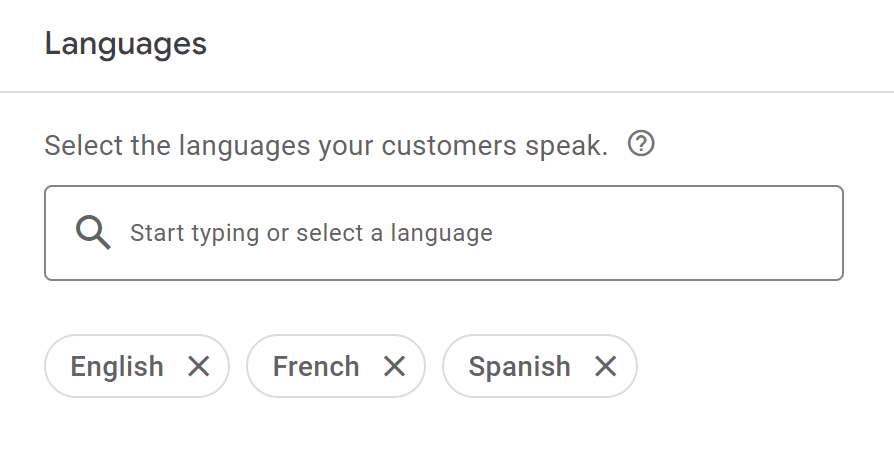
And you have the option to target by audience segment:
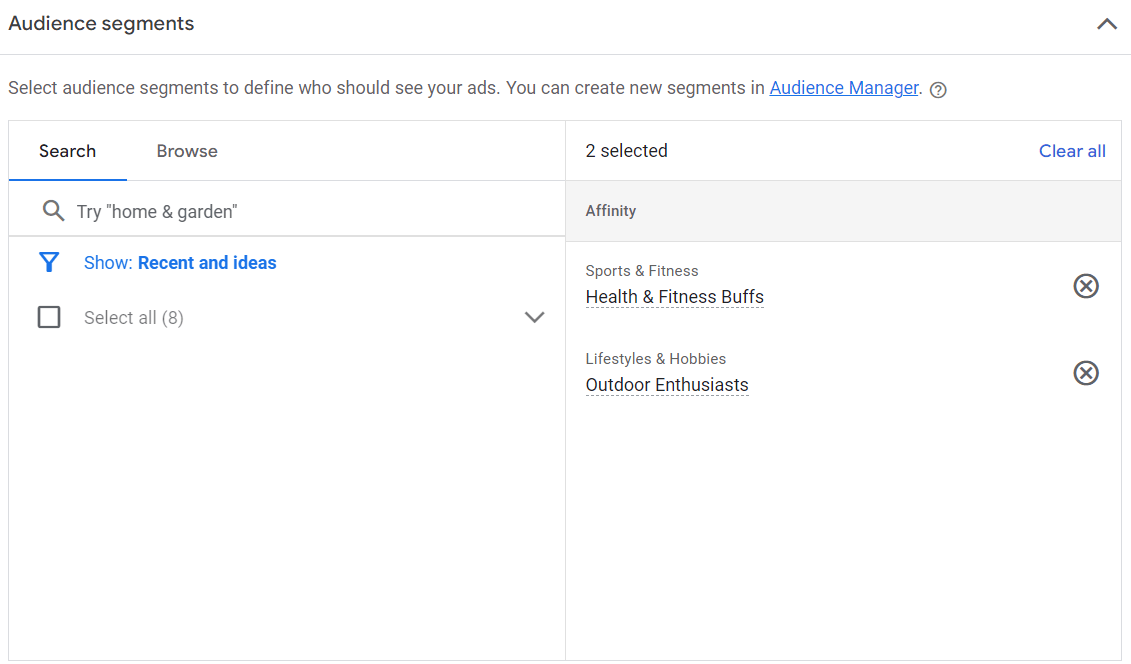
Then, YouTube’s algorithm uses these criteria to place your ads in front of users who fit your desired profile.
For example, let’s say you have a North American business.You want to sell a new line of eco-friendly water bottles. You might use Google Ads to target viewers in your region interested in outdoor activities. Or health and wellness. That way, your ad connects with people already inclined to care about your product.
Benefits of YouTube Ad Targeting
YouTube ad targeting helps you:
- Specify your audience based on their demographics, interests, and even online behaviors. Like the types of videos they watch on YouTube. And things they search for on Google.
- Measure success in real time by tracking your ads’ performance against your marketing goals. Like increasing brand awareness and driving conversions.
- Re-engage with viewers who have previously interacted with your brand. This can significantly increase your chances of conversion. Since these individuals have shown interest in your brand before.
- Target peak viewing times by specifying when Google should show your ads. This helps you find your audience better. And limit exposure to avoid ad fatigue. (That happens when an audience sees the same ad too often.)
How to Target Ads on YouTube
There are two types of YouTube ad targeting methods:
- YouTube Ads audience targeting: Focuses on who is viewing the ad
- YouTube Ads content targeting: Focuses on where your ad is shown
Let’s look at each.
Audience Targeting Methods for YouTube Ads
Audience targeting methods help your ads reach the people most likely to be interested in your offering.
Audience targeting methods include:
- Demographic groups: Specify the basic demographics of your target audience. Like their age, gender, whether they have children, and how much they earn.
- Detailed demographics: Target users based on life stages or statuses. Like college students or homeowners.
- Interests: Target viewers based on their interests. This shows your ads to people interested in topics related to your business. Even if they see the ad when they’re watching videos about something else.
- Affinity segments: Target video ads at people with a strong interest in topics related to your brand
- Custom affinity segments: Customize your audience segments even more precisely. For example, instead of targeting all “chocolate lovers,” a gourmet chocolate company might target “artisanal dark chocolate connoisseurs.”
- Life events: Target audience based on life events. Like moving, graduating, or getting married.
- In-market segments: Target people who are actively researching products or services like yours
- Custom segments: Tailor your audience based on their Google searches
- Your data segments: If people have interacted with your brand—through your YouTube videos, ads, channel, website, or app—you can target your ads to them again. This is called retargeting.
- Customer Match: Use your first-party data to reconnect with your customers across YouTube. Whether they’ve shopped with you online or in-store, use what you know about them to bring your brand back into their view. You can also use Customer Match to attract new customers who are similar to your existing ones.
There are two ways to use Customer Match:
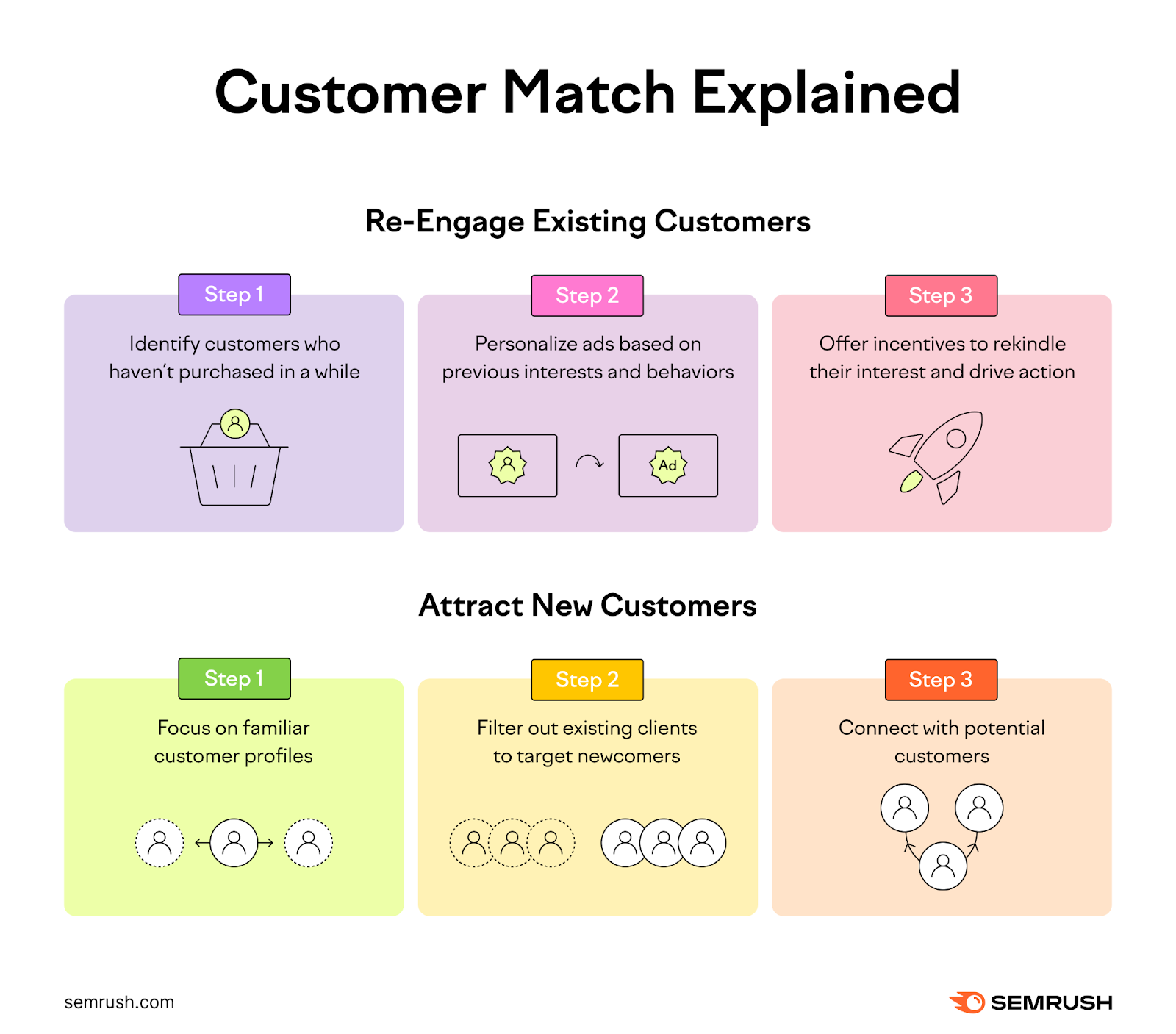
Content Targeting Methods for YouTube Ads
With content targeting methods, you focus on choosing specific digital spaces. These are places—like certain videos, channels, or websites—where you want your ads to appear.
Content targeting methods include:
- Placements: Think of placements as choosing the exact digital real estate for your ads. You select specific YouTube channels and individual YouTube videos where you want your ads to appear. You also have the option to choose entire websites—or even specific pages within websites—through the Google Display Network (GDN).
- Topics: Target YouTube videos, channels, and websites related to specific subjects. For example, if your business involves outdoor adventure, targeting the “Travel & Adventure” topic means your ads should appear on related content. Like videos with backpacking tips on YouTube. Or travel blogs on the GDN.
- Keywords: With YouTube Ads keyword targeting, you select specific words or phrases to match your ads with YouTube content. Let’s say you’re promoting a new cookbook. Targeting keywords like “cooking tutorials” or “recipe reviews” can help your ads appear alongside related cooking videos or food channels.
- Devices: Choose the type of device you want your ads to appear on. For example, mobile phones, computers, or even TV screen devices like Chromecast.
Types of YouTube Ads
There are several types of YouTube targeted ads to select from.
Here’s a quick overview:
Types of YouTube Ads |
||||
|
Ad Type |
Where They Can Appear |
Max Video Length |
Skippable? |
Ideal for |
|
Skippable In-Stream |
Before, during, or after videos on YouTube and Google video partners (GVP) |
None, but Google recommends less than three minutes |
Yes, after 5 seconds |
Brand awareness, product consideration |
|
Non-Skippable In-Stream |
Before, during, or after videos on YouTube and GVP |
15-30 seconds |
No |
Messages that you need users to see in full |
|
In-Feed Video |
YouTube search results, homepage, or next to related videos |
None |
N/A (viewer chooses to click and watch) |
Engaging viewers actively searching or browsing |
|
Bumper |
Before, during, or after videos on YouTube and GVP |
Six seconds |
No |
Short, memorable brand messages |
|
Outstream |
On partner sites and apps outside of YouTube |
None |
N/A (ad is the only video displayed in the space) |
Extending reach beyond YouTube, mobile-focused |
|
Masthead |
At the top of YouTube’s homepage |
30 seconds |
N/A (ad is the only video displayed in the space) |
Major product launches, brand events |
Let’s look at each option in more detail.
Skippable In-Stream Ads
Skippable in-stream ads are common on YouTube. They play before, during, or after the user’s chosen video.
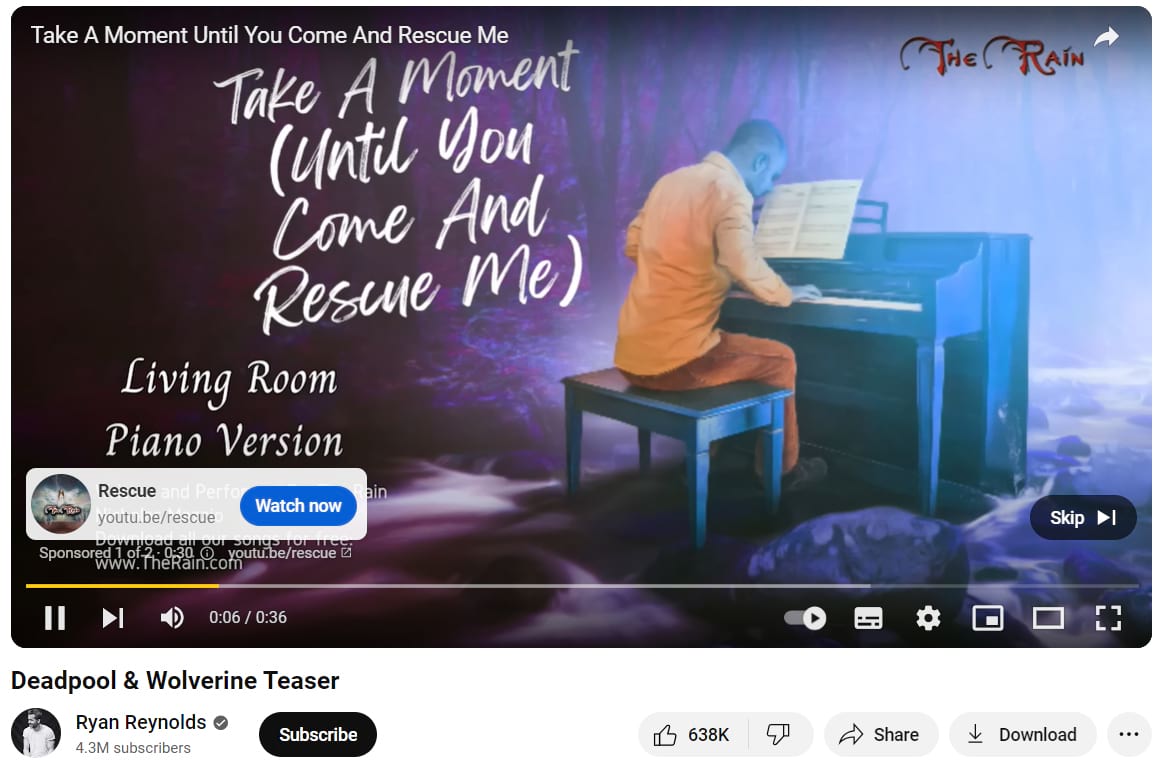
These ads offer a flexible viewing experience. Viewers can skip after five seconds. And you only pay when a viewer watches your ad for at least 30 seconds, until the end of the video, or if they engage with the ad, like clicking on a call to action (CTA).
Skippable in-stream ads are effective when you have engaging video content you want to promote on YouTube or across the GDN. They’re ideal for capturing attention quickly. You can customize them with CTAs. And overlay text to encourage viewer interaction.
Imagine you’re launching a new fitness app and want to spread the word. You might create a skippable in-stream ad. It could start with a captivating question: “Looking to transform your fitness journey?” Within the first five seconds, your ad shows great visuals. It features real people achieving their fitness goals. It intrigues viewers, increasing the likelihood they’ll watch the rest of the ad. Or click through to learn more about your app.
Non-Skippable In-Stream Ads
Non-skippable in-stream ads are video ads. Viewers must watch them before the main video.
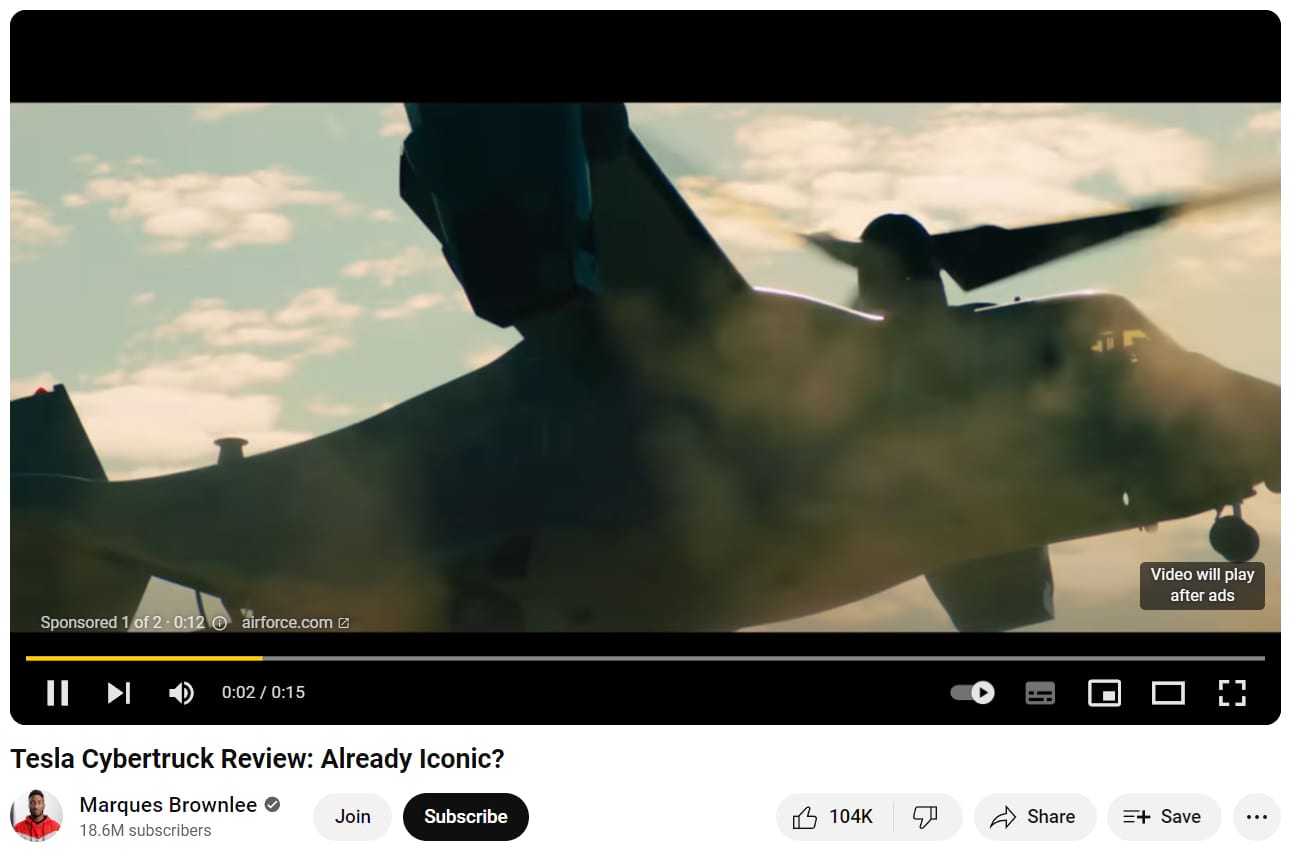
These ads can be up to 30 seconds long. Google Ads can place them before, during, or after the YouTube video the viewer is watching. They deliver your whole message. Viewers can’t skip them. This ensures your audience sees your complete ad.
Non-skippable in-stream ads are most effective when you have a concise, powerful message. Because viewers cannot skip these ads, they’re ideal for making a swift, solid impact. They work well for announcements or product launches.
Let’s say you’re launching a new smartphone with unique features. A non-skippable in-stream ad could be the perfect format to showcase this product. You have a captive audience for 15-30 seconds. Enough time to highlight the phone’s most innovative features. And end with a CTA encouraging viewers to learn more on your website.
For non-skippable in-stream ads, it’s important to consider its potential impact on the viewer. Because they can’t be skipped, these ads can frustrate viewers if they aren’t relevant.
Non-skippable in-stream ads might be right if:
- Your message is compelling and concise, delivering value within a short period of time
- Your content is engaging enough to hold viewers’ attention for the entire duration
- You have specific goals like raising brand awareness or driving sales of a new product
In-Feed Video Ads
In-feed video ads appear where viewers find content. They show next to YouTube search results, in the list of related videos on a watch page, or on the YouTube mobile homepage. Like this:
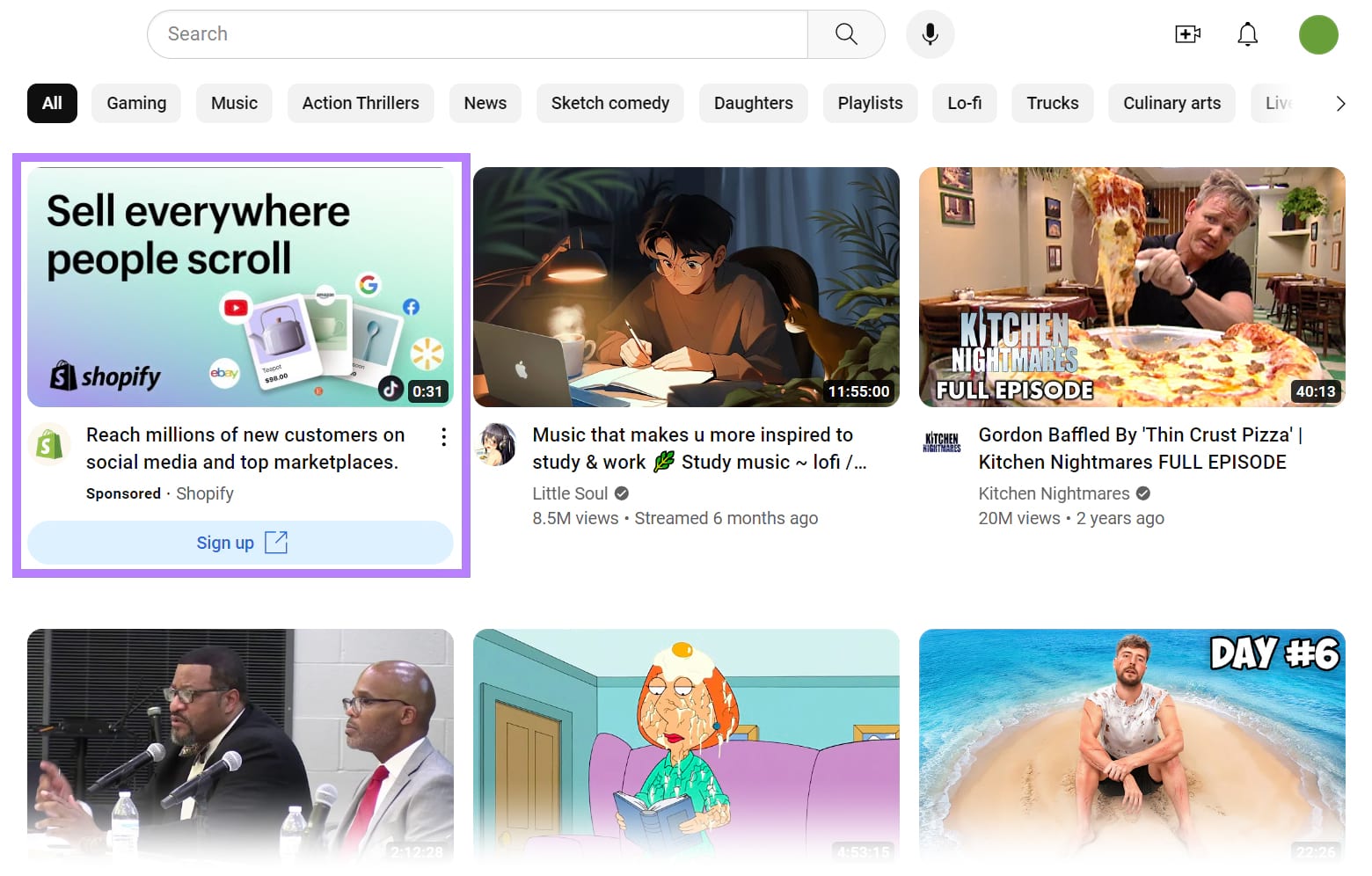
These ads consist of a thumbnail image from your video and some text. Viewers have to click to watch more. When they click, the video plays on its dedicated YouTube page or channel.
In-feed video ads work well for attracting customers who are already interested in content like yours. They blend seamlessly into the user’s browsing experience, making them less intrusive and more likely to be clicked. This makes in-feed video ads ideal for promoting your content directly to users looking to discover something new or relevant to them.
For example, you run a cooking channel about healthy eating. Your in-feed video ad may show your series’ trailer where food enthusiasts are likely to see it. In search results for “healthy eating recipes” or as a related video on popular cooking tutorials.
Bumper Ads
Bumper ads are quick, impactful snippets that play right before, during, or after a YouTube video. They are six seconds long and there is no option to skip them. This ensures your audience sees your entire message.
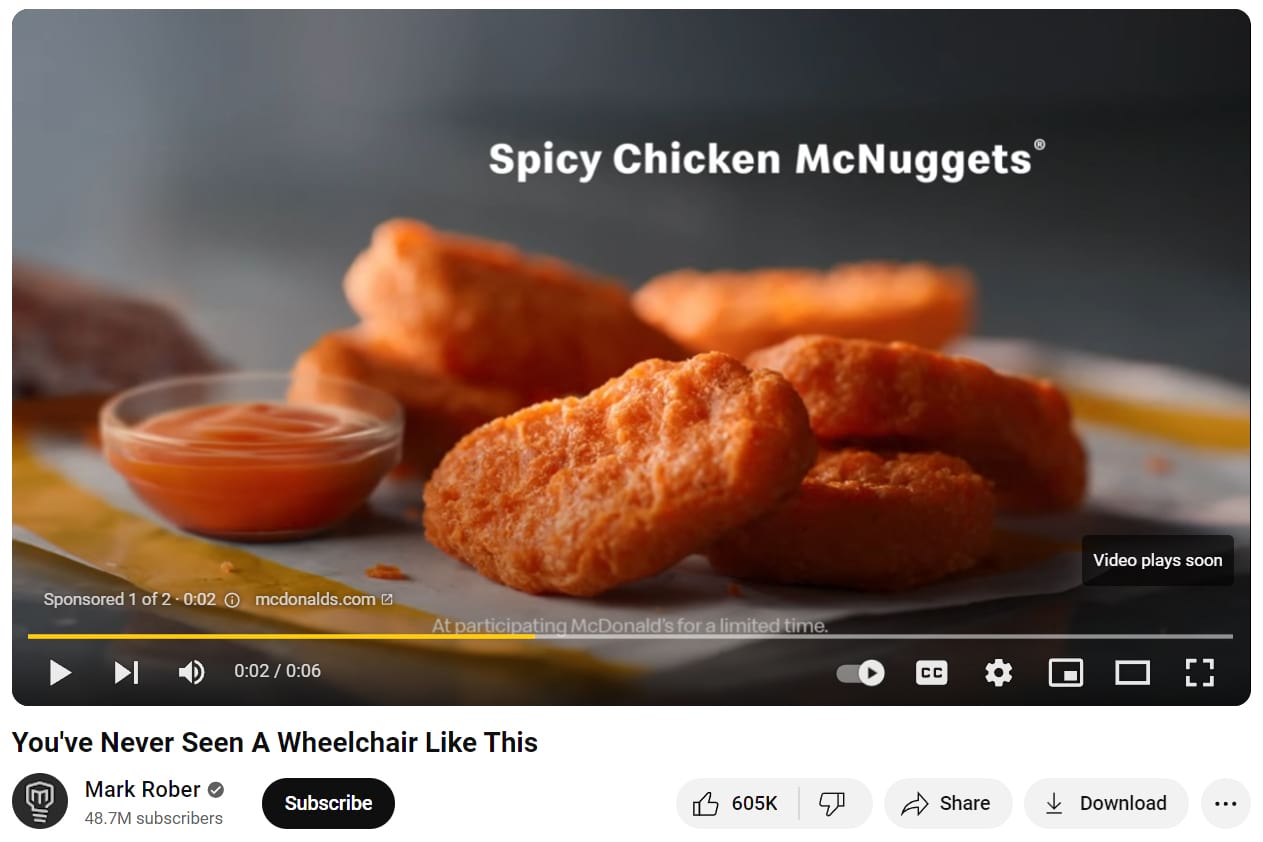
These ads are practical when you want to deliver a short, memorable message to a broad audience. Use them to reinforce or complement a larger advertising campaign. Like for a new product launch or an upcoming event.
Let’s say you’re launching a new line of custom sneakers. Your bumper ad could feature quick, dynamic shots of the sneakers in action, and close with your logo and a simple, catchy slogan. This brief glimpse can spark viewers’ interest. And complement a more detailed campaign elsewhere.
Outstream Ads
Outstream ads are a mobile-specific advertising format. It helps you broaden your video ad’s reach beyond YouTube. These ads target viewers on websites and apps within the Google Video Partners (GVP) network.
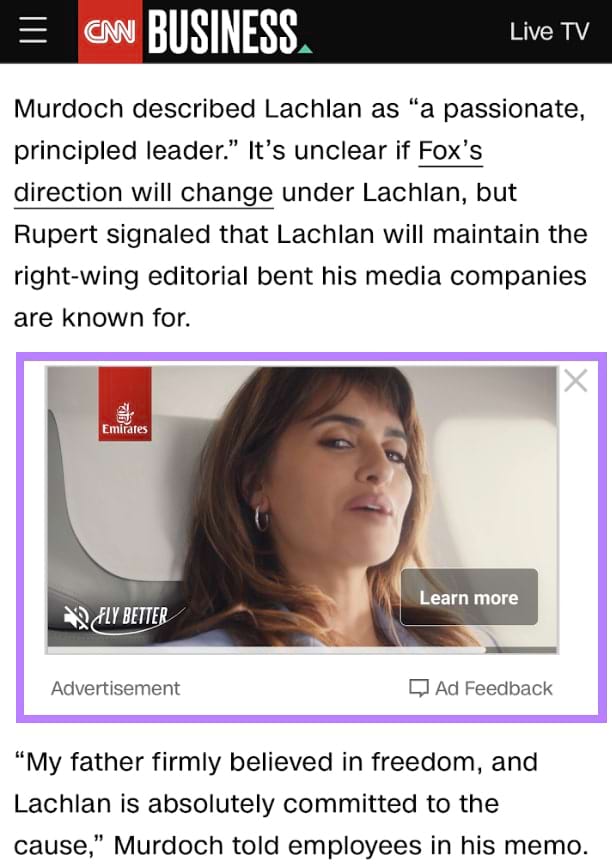
These ads automatically start playing without sound. Viewers can tap the ad to unmute it. This approach makes outstream ads non-intrusive. They give users control over their experience.
Outstream ads are most effective in connecting with mobile users who frequently consume content on apps and websites beyond YouTube. This strategy is valuable for reaching a broader audience likely to have an interest in your content or offerings.
Imagine you’re promoting a new mobile game. Using outstream ads, you place a short, silent teaser of your game in banners across a variety of apps and mobile websites. Interested viewers can tap to unmute and watch the entire ad, potentially leading to a new app download.
Masthead Ads
Masthead ads appear at the top of YouTube’s homepage. Like this:
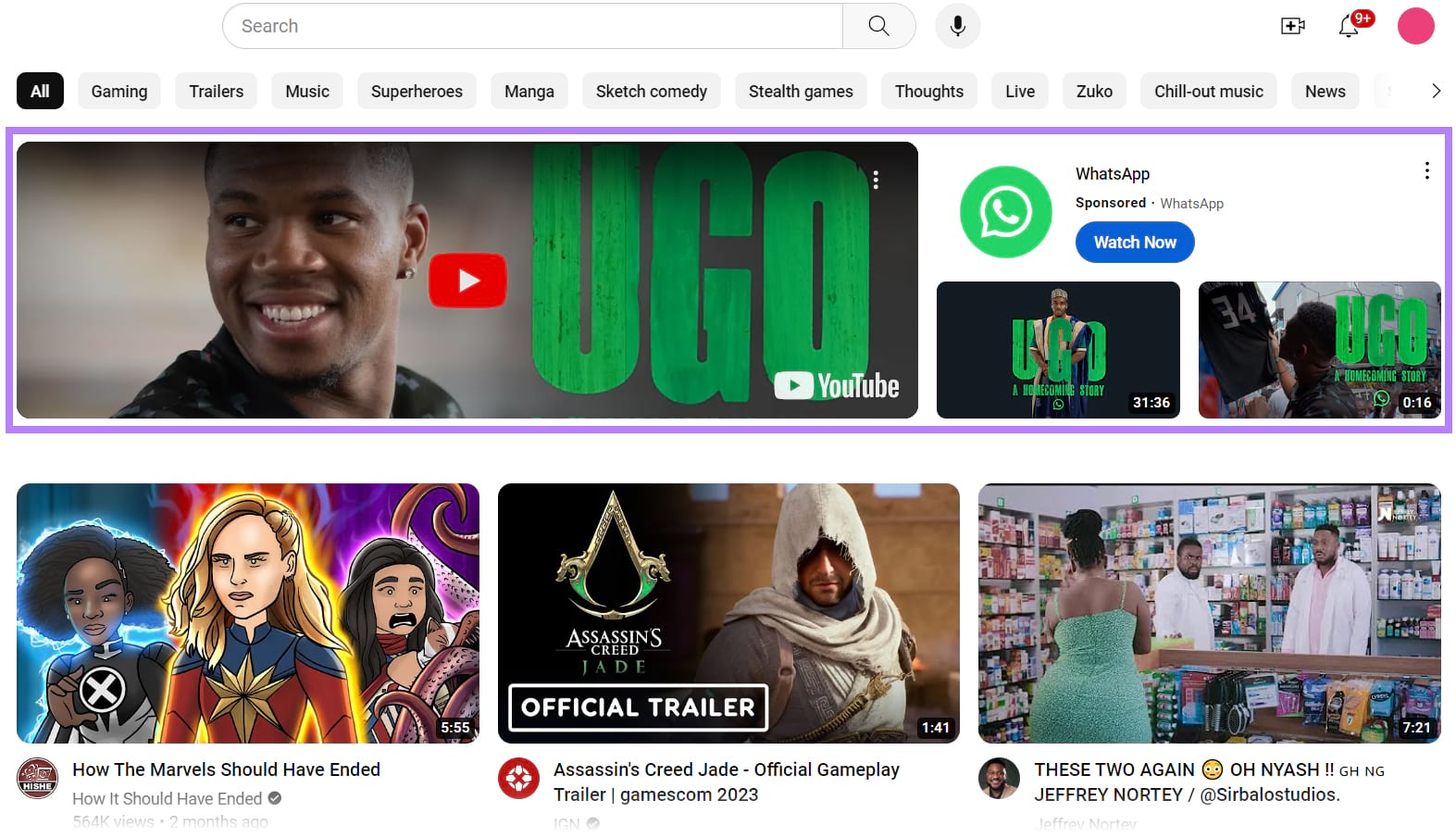
They instantly catch the eye of anyone who visits the site, auto playing without sound for up to 30 seconds. They offer a prime spot to showcase your brand or product in a widescreen or 16:9 aspect ratio format.
Masthead ads are effective for significant marketing campaigns. Like when you want to generate awareness about a new product launch, service, or an important event, like a sale. Use them when you want to make a big announcement and capture tons of attention in a short amount of time.
Let’s say your company is launching a new product feature, and you want to create the biggest possible impact on launch day. A masthead ad could feature a 30-second teaser showing the benefits of the new feature.
How to Set up Your YouTube Ad Campaign
You need a Google Ads account and a YouTube channel to set up your first YouTube Ad campaign.
Link the accounts so they share data. This provides more advertising opportunities seamlessly.
Start in your YouTube Studio account. Click “Settings” in the left-hand menu.
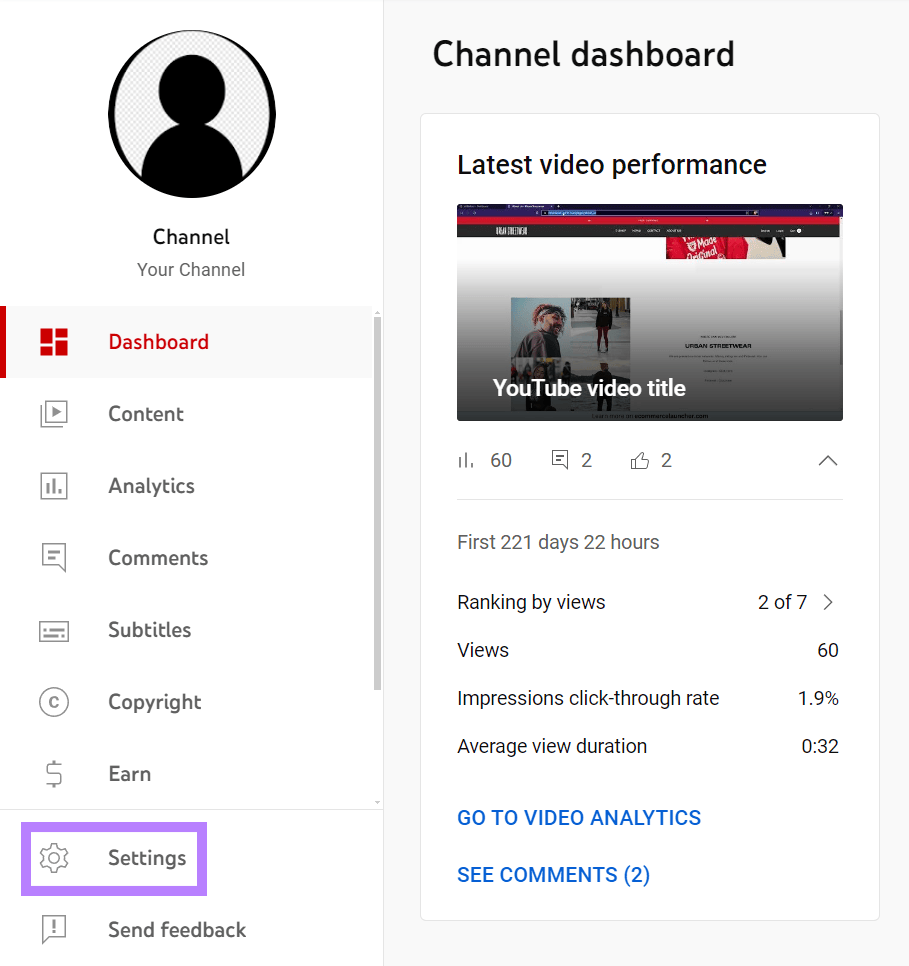
Click on “Channel.”
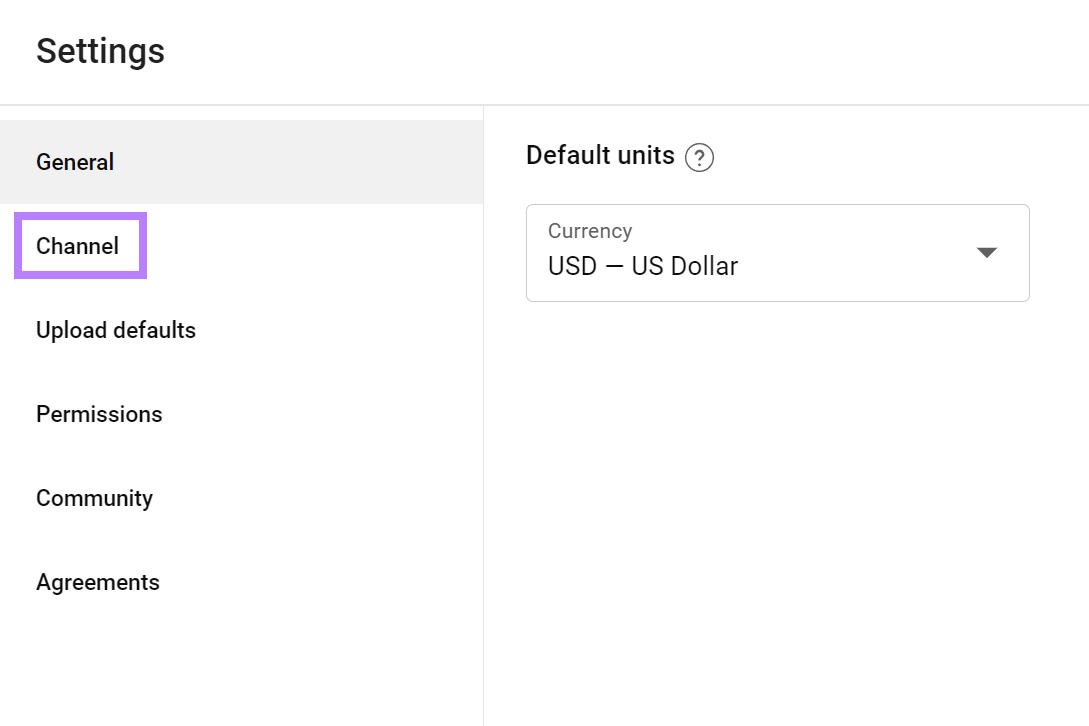
Click on the “Advanced settings” tab.
Then, click “LINK ACCOUNT” at the bottom. Next to “Google Ads account linking.”
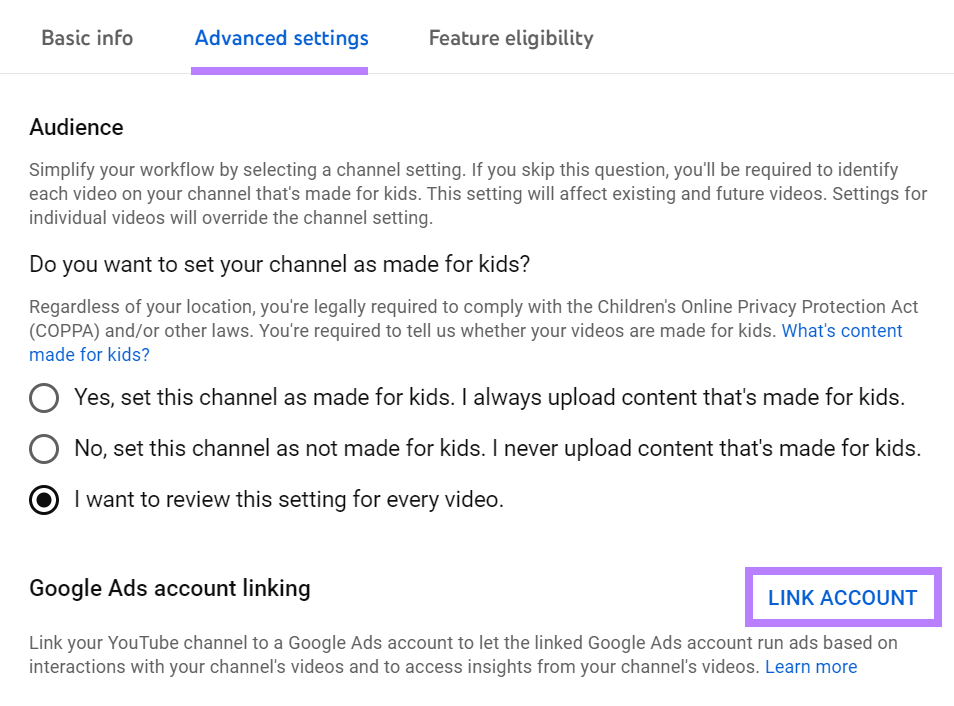
Enter the necessary information. Click “DONE.”
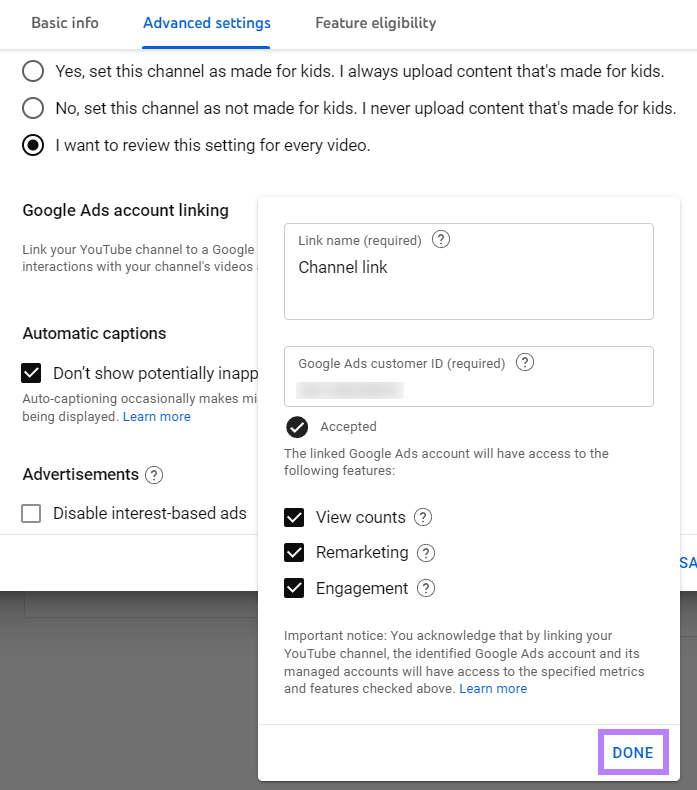
Next, log in to your Google Ads account to approve the request. This should successfully link your accounts.
Make sure you have uploaded your ad as a video on YouTube. This step is crucial. It’s the only way to designate that video content as a YouTube ad.
Now you’re ready to create that YouTube ad campaign.
1. Create a New Campaign
On your Google Ads account page, click on the “+ Create” button at the top of the navigation bar on the left.
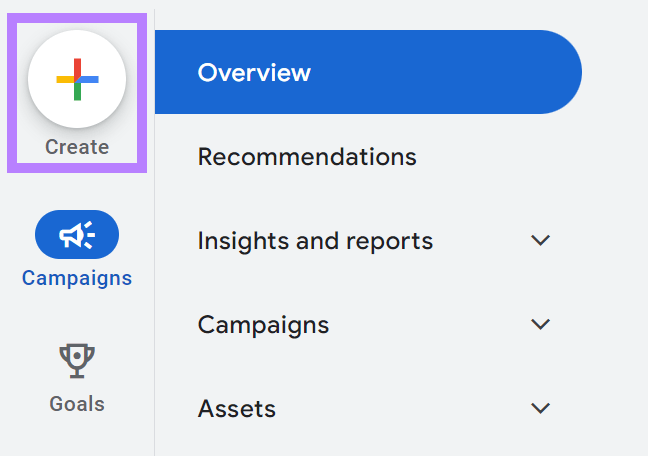
Select “Campaign.”
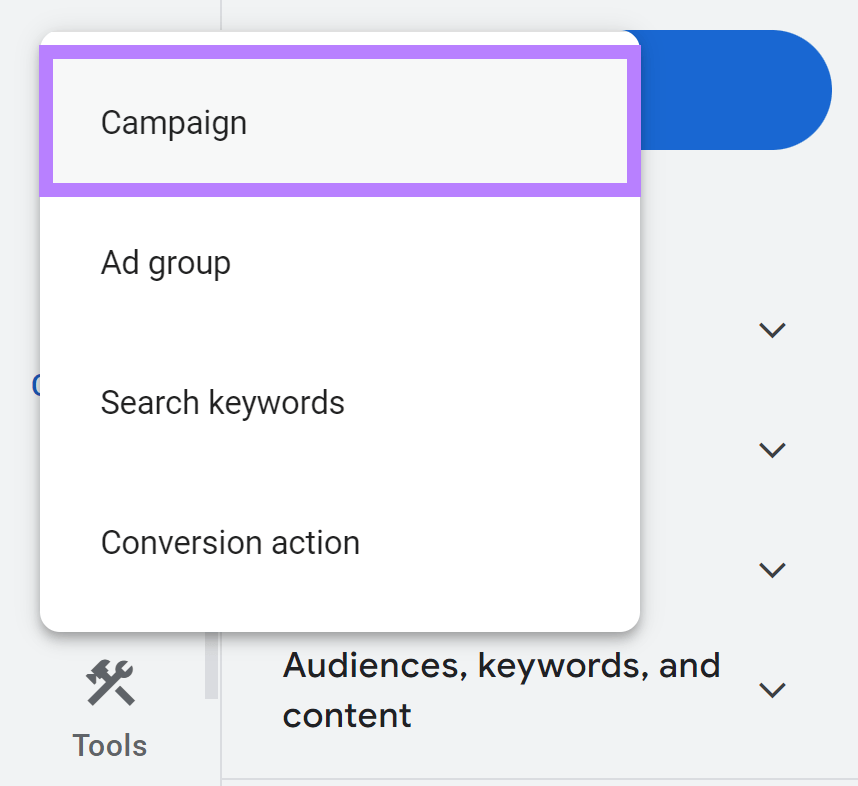
2. Select Your Campaign Objective
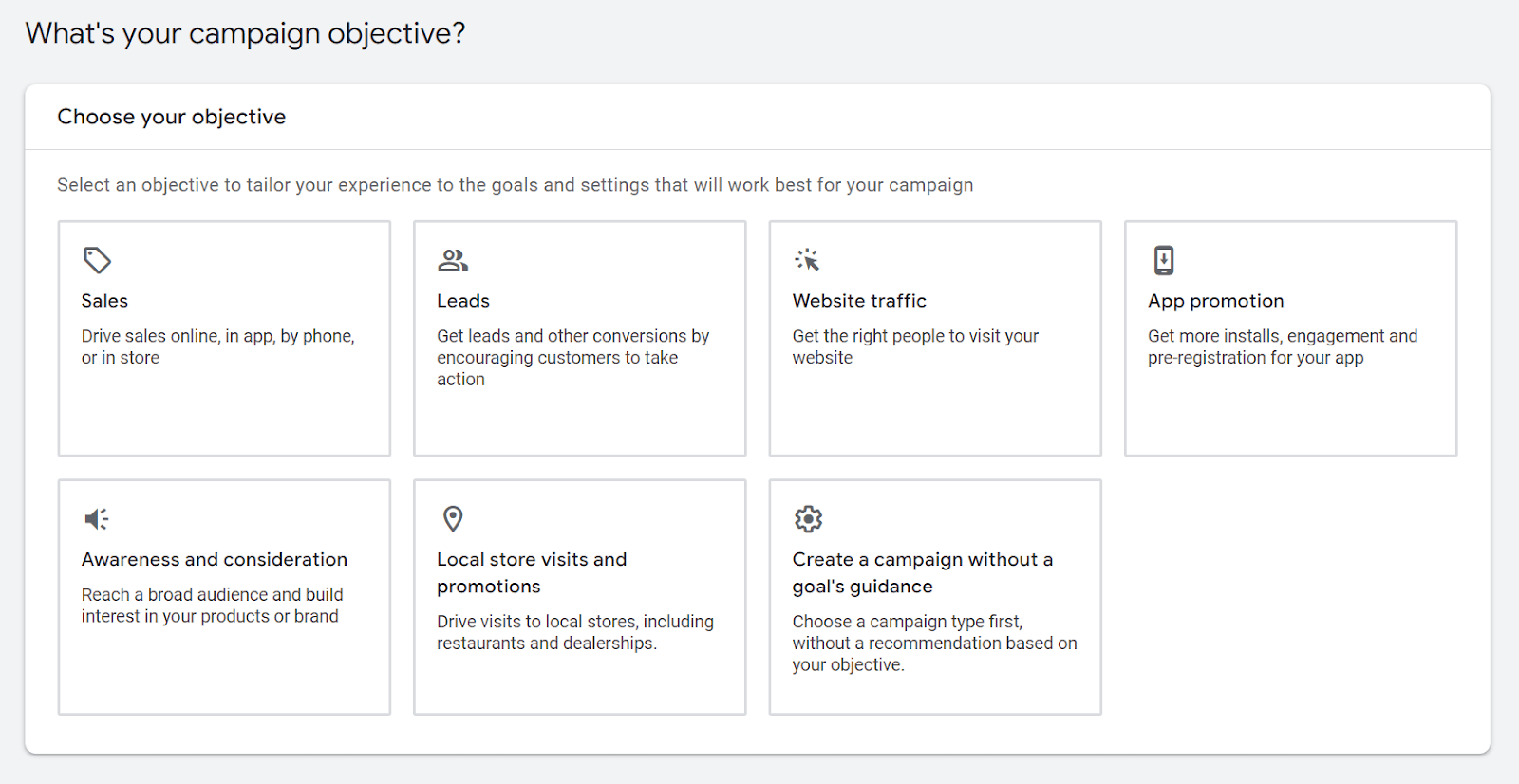
The campaign objective you select will dictate which ad types will be available to you.
For example:
- Skippable in-stream ads are available for sales, leads, website traffic, and awareness and consideration objectives
- Non-skippable in-stream, in-feed video, and bumper ads are available for awareness and consideration objectives
For this workflow, we chose the “Awareness and consideration” objective.
Next, under “Select a campaign type,” choose “Video.”

A menu of campaign subtypes will appear. Select one. Then click the “Continue” button.
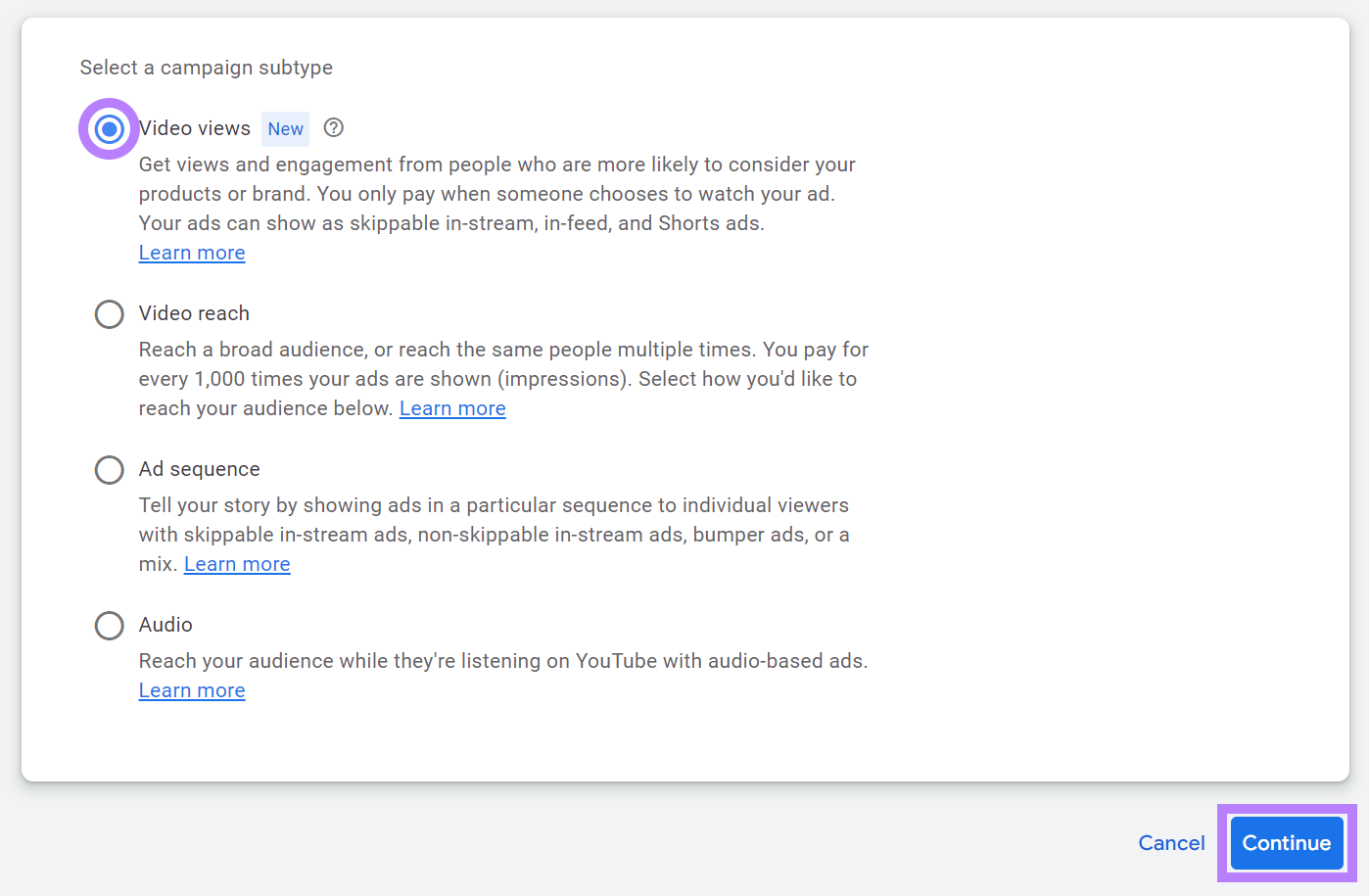
Consider the following tips when selecting a campaign subtype:
- Video views: An idea choice if want deep engagement with those most likely to be interested in your offerings
- Video reach: Best for maximizing visibility or reinforcing your message by showing it to the same people repeatedly
- Ad sequence: Perfect for storytelling or complex messages that unfold over multiple interactions
- Audio: Suited for reaching users listening on YouTube Music
- YouTube engagements: Ideal to grow your channel’s community and increase interaction with your content
If you choose objectives like Sales, Leads, or Website traffic, you have to add a conversion goal to track that objective.
Let’s say you select the “Sales” objective. Click on “Add goal” under “Use these conversion goals to improve Sales.”
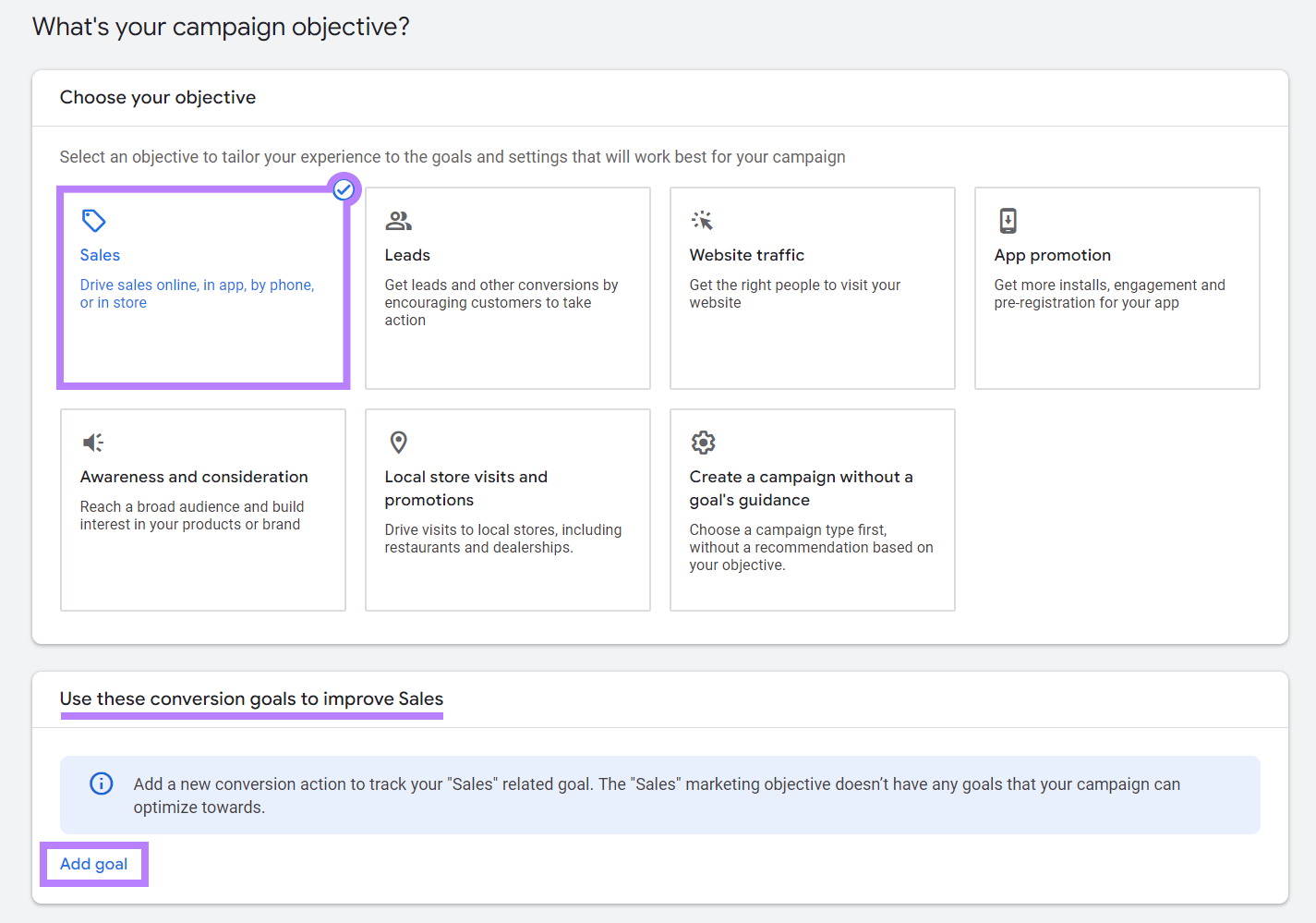
Select your conversion goal.
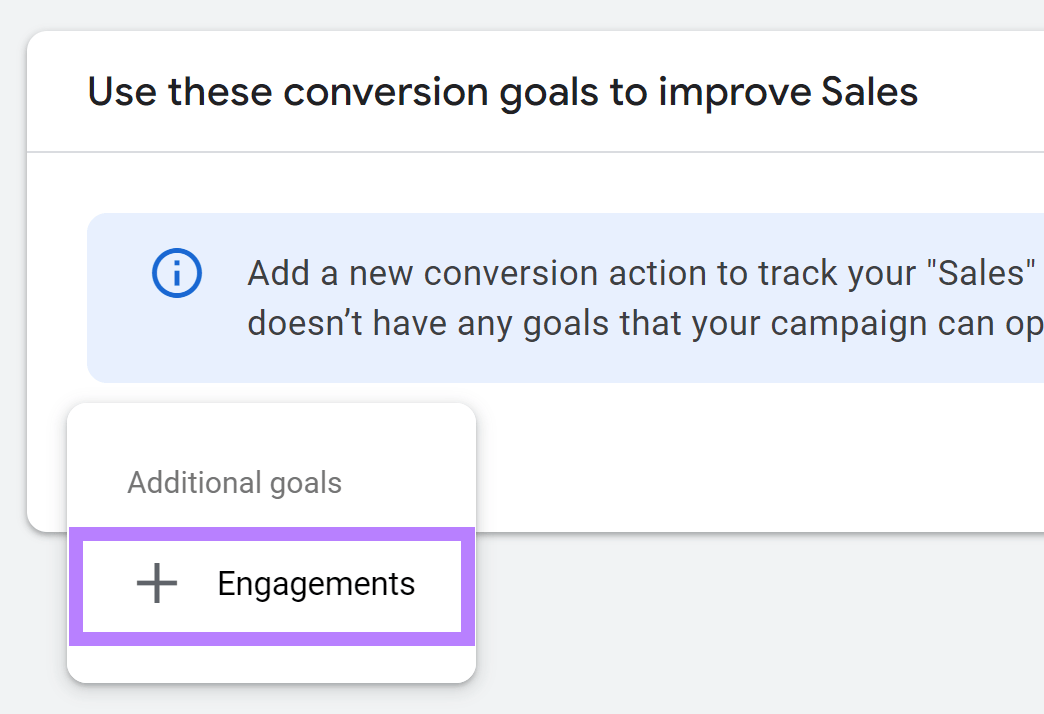
Then, click “Continue.”
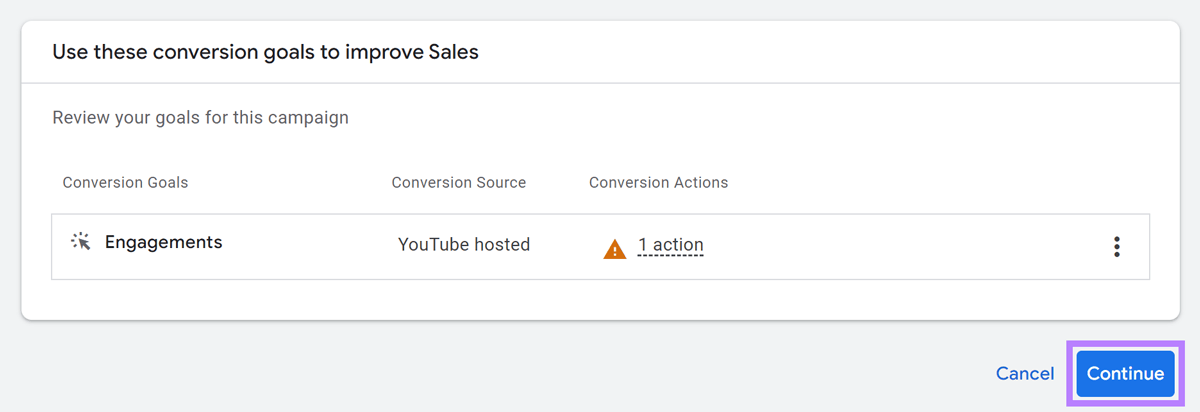
Set your campaign type as “Video,” and click “Continue.”
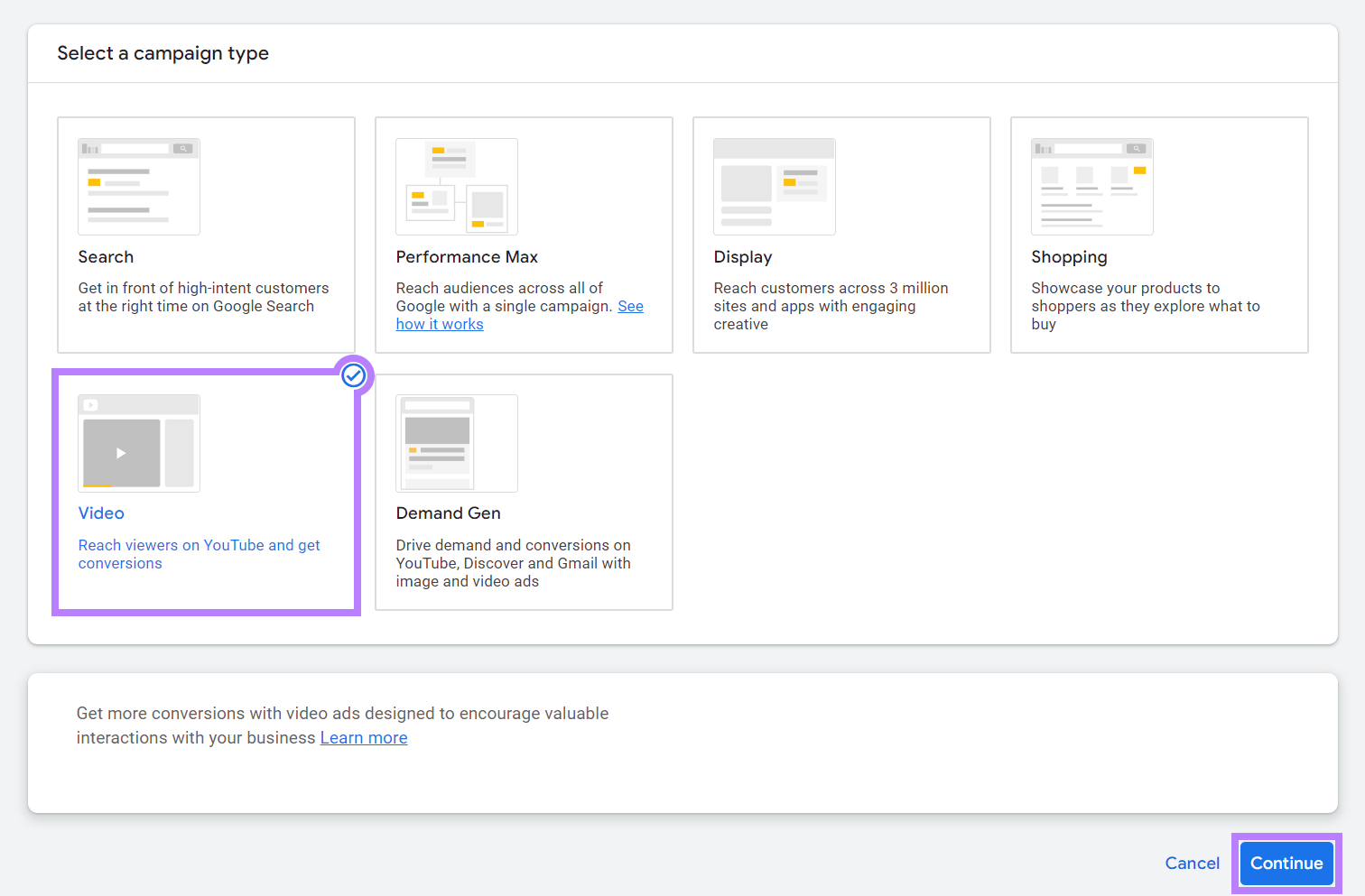
3. Define Your Campaign Settings
Name your campaign.

Next, you’ll select your budget type and total.
Choose between the “Daily” and “Campaign total” budget types.
- Daily: Offers day-to-day spending control to adapt to daily viewership fluctuations. You may spend less than your daily budget on some days and more on others. However, you won’t spend more than your daily budget times the days in the month. This flexibility is ideal for achieving consistent visibility without overspending.
- Campaign total: A set-it-and-forget-it approach where you allocate a total spend for the entire campaign duration.YouTube strategically paces your spending based on your campaign’s start and end dates. It evenly distributes ad exposure over that period.
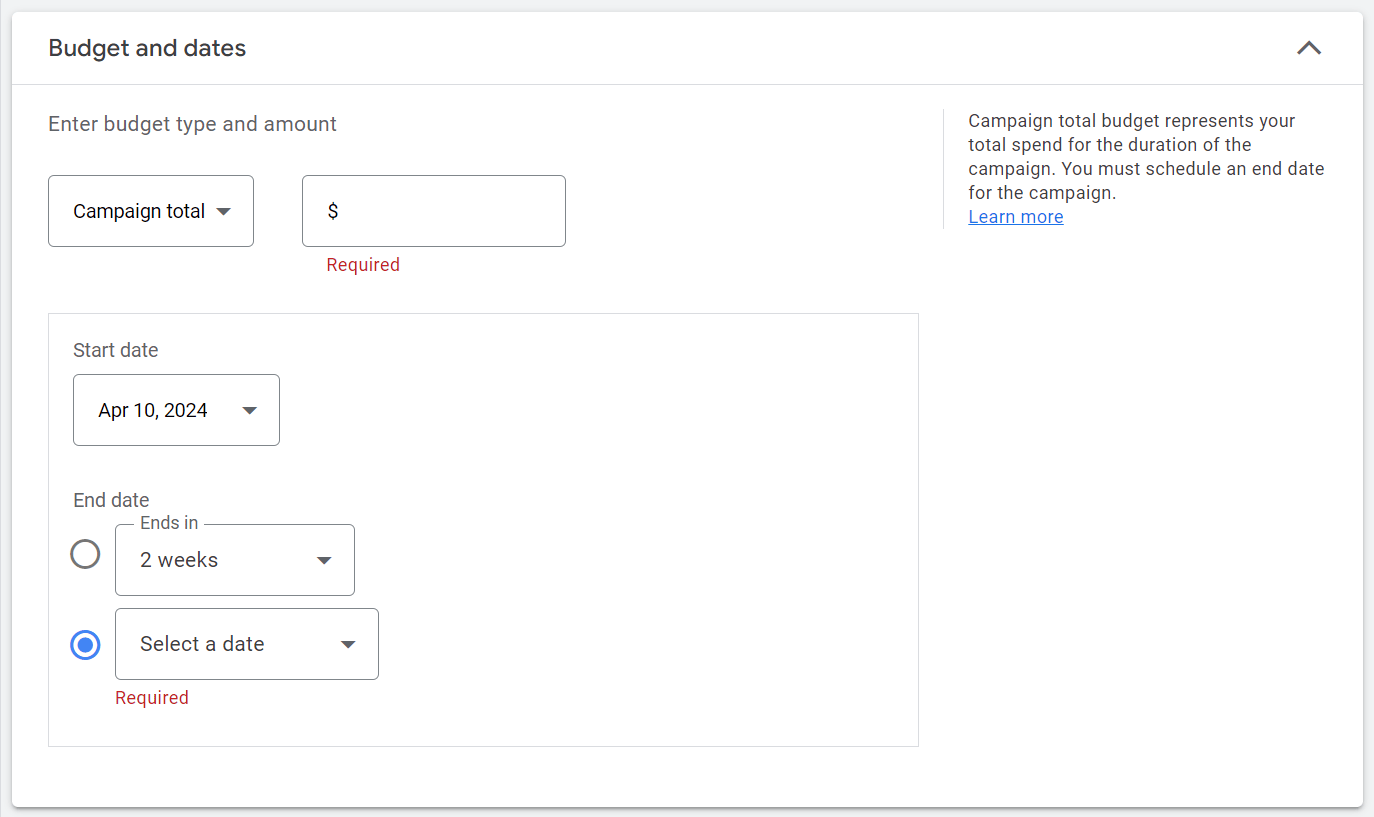
Next, select your networks. And your target audience’s geographic location.
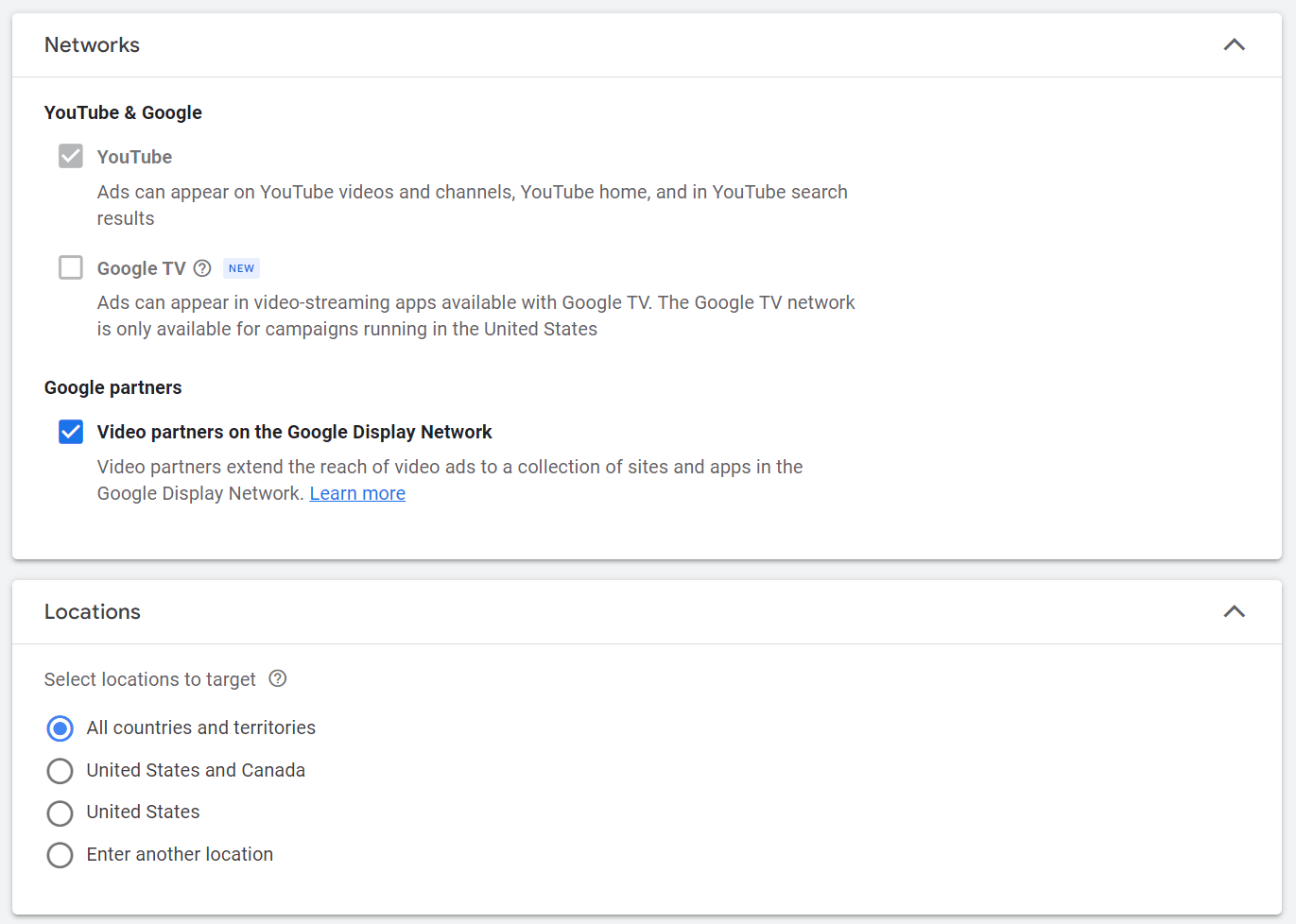
Select the languages your target audience speaks. And add related videos for better engagement.
Then, tick the “Get more views with multi-format video ads” checkbox. This allows Google to find the right mix of ad types for your campaign.
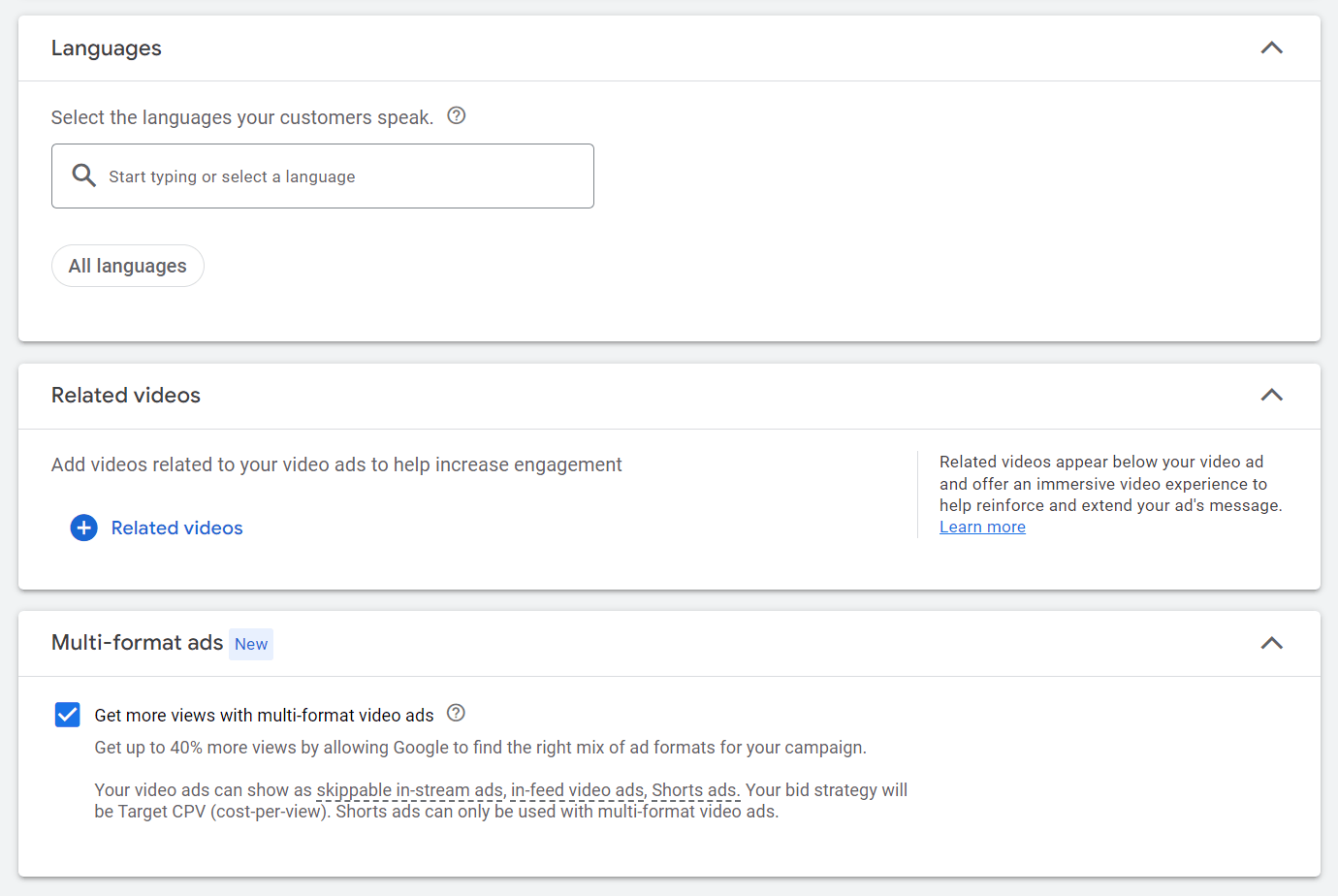
Click on “Additional settings” if you want to:
- Target specific devices
- Set how many times Google Ads shows your YouTube ad to a user
- Schedule when your targeted ads on YouTube can run
- Add third-party vendors to let them see measurement data for your campaign

4. Create Your Ad Group and Ad Content
Name your ad group.

Scroll down to the “People” section to adjust target audience criteria. Expand the “Demographics” option to open a menu of selectable options.

Use the checkboxes to specify your target audience’s age, gender, parental status, and household income.
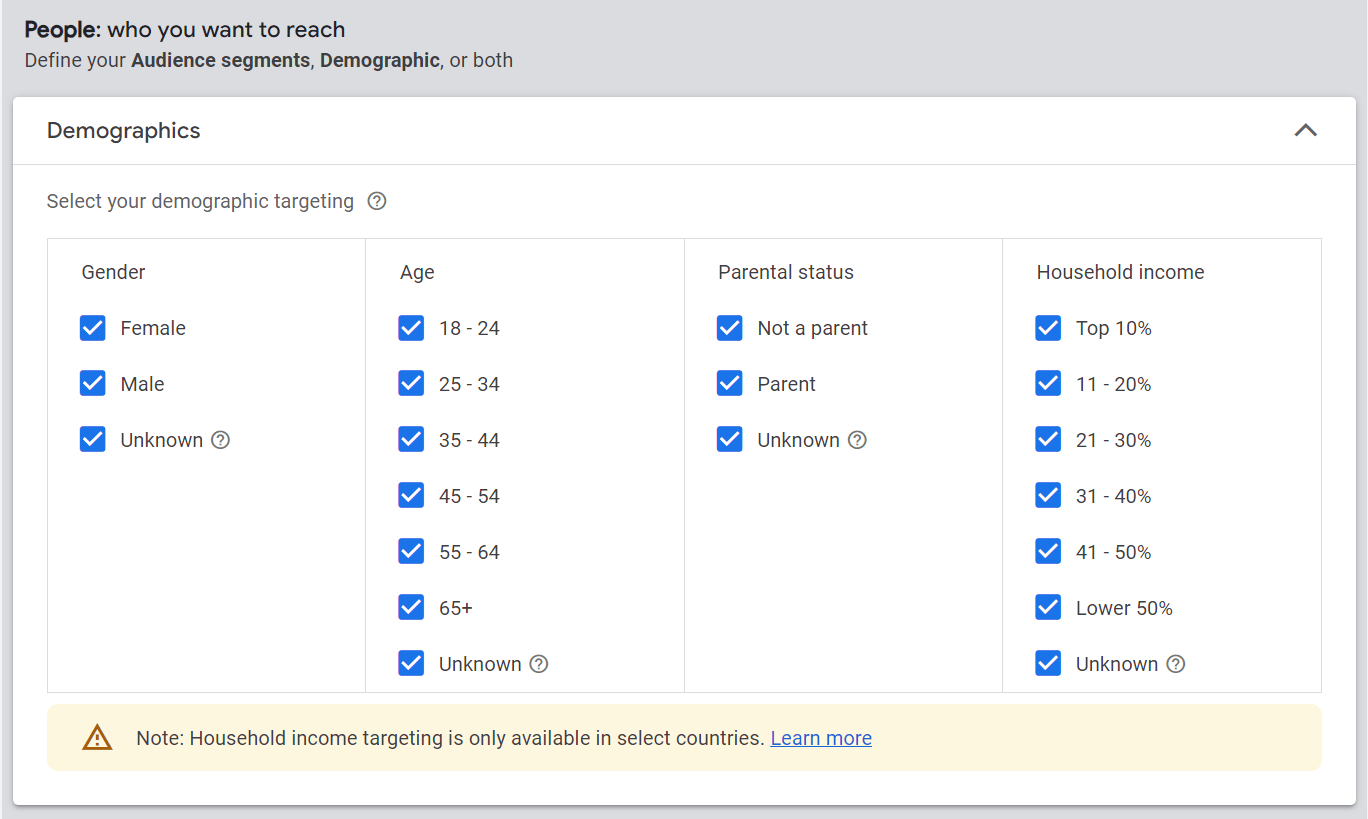
Expand the “Audience segments” menu to create specific groups. These groups are the people you want Google Ads to target with your YouTube ads based on factors like demographics and interests.
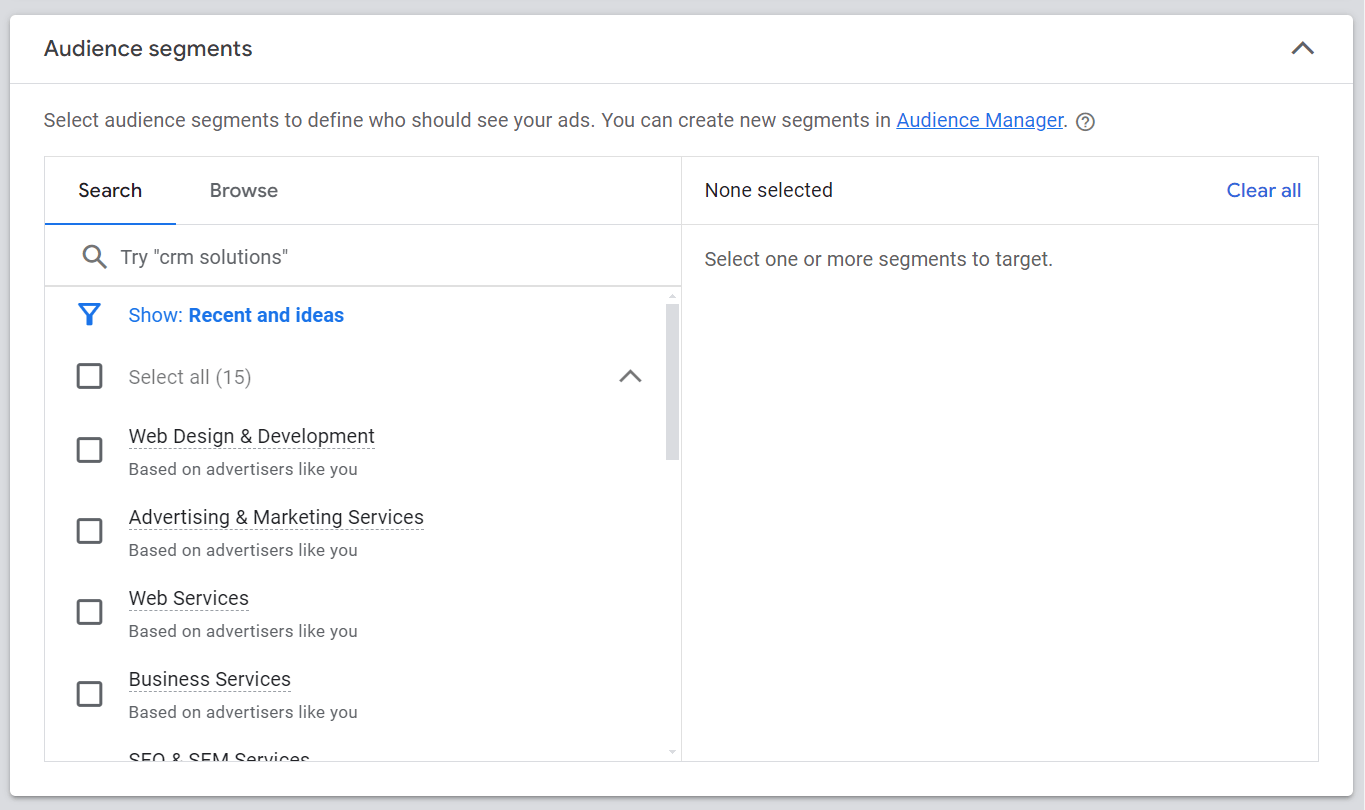
Scroll down to the “Content” section to set preferences about the type of content that will trigger your ads to display. Expand the “Keywords” menu.

Add keywords that describe your product or service. And the content you want your ads to appear on.
For example, if you’re selling handmade bracelets, use keywords like “handmade jewelry,” “artisan bracelets,” and “unique accessories.”
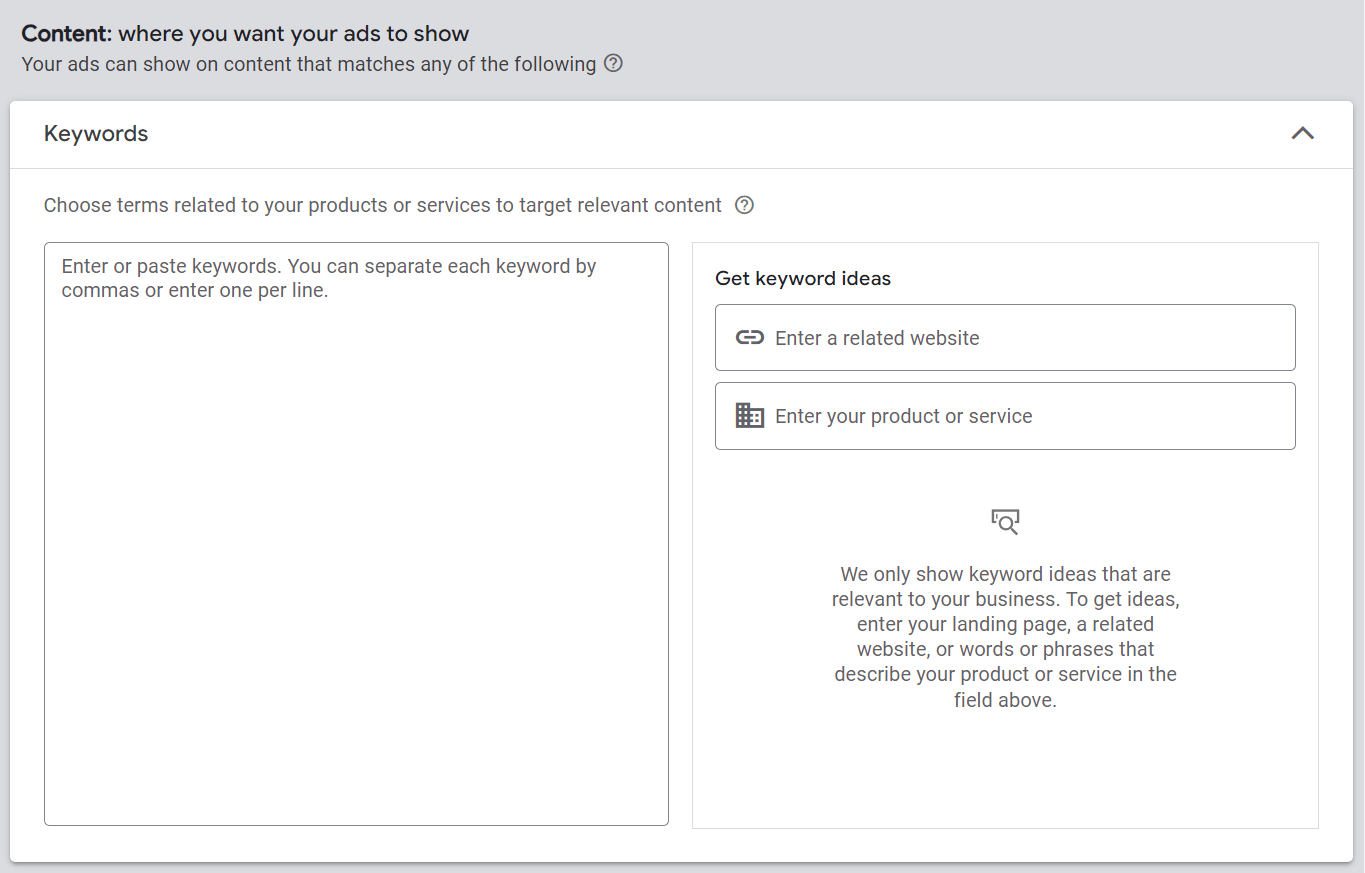
Select “Topics” to specify the content subjects for your ads.
Topics are broader content themes. They differ from keywords, which target specific terms.
To build on our previous example, if you’re advertising handmade bracelets, you might select topics like “Fashion & Beauty” or “Arts & Crafts.”

Expand the “Placements” menu to specify where on GDN or YouTube you want your ads to go.
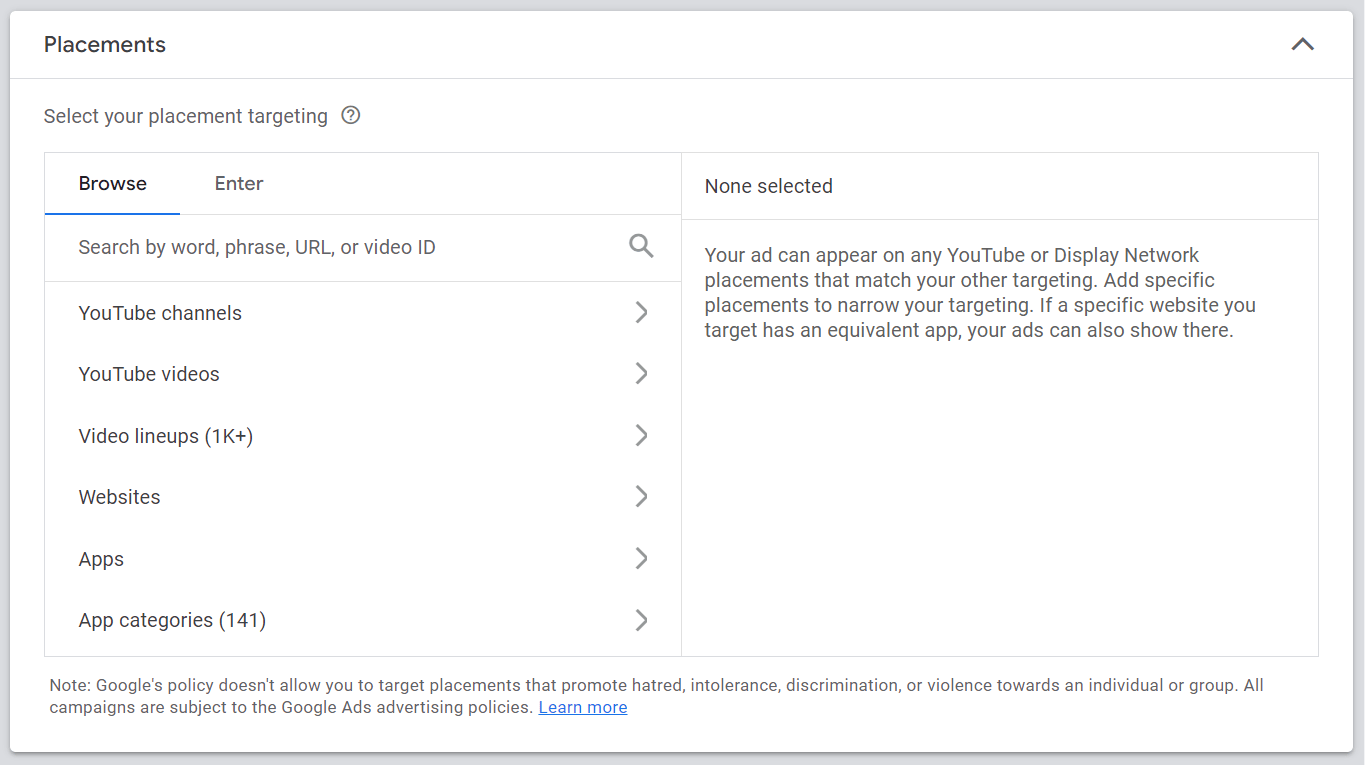
Under the “Create your video ads” section, search for the video you want to be your ad. Or add it via YouTube URL.
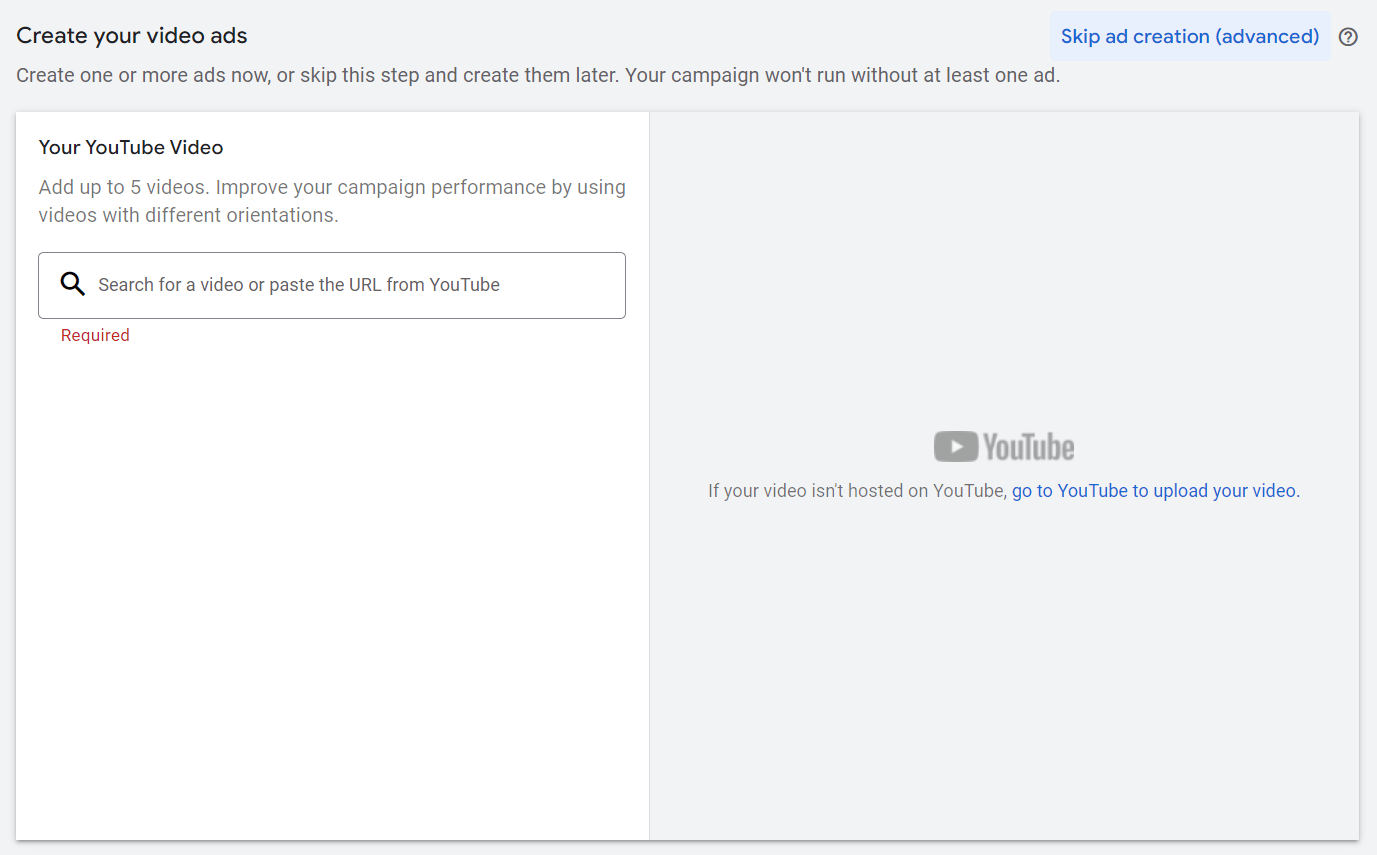
After adding your video, input the final URL where you want users to land when they click your ad.
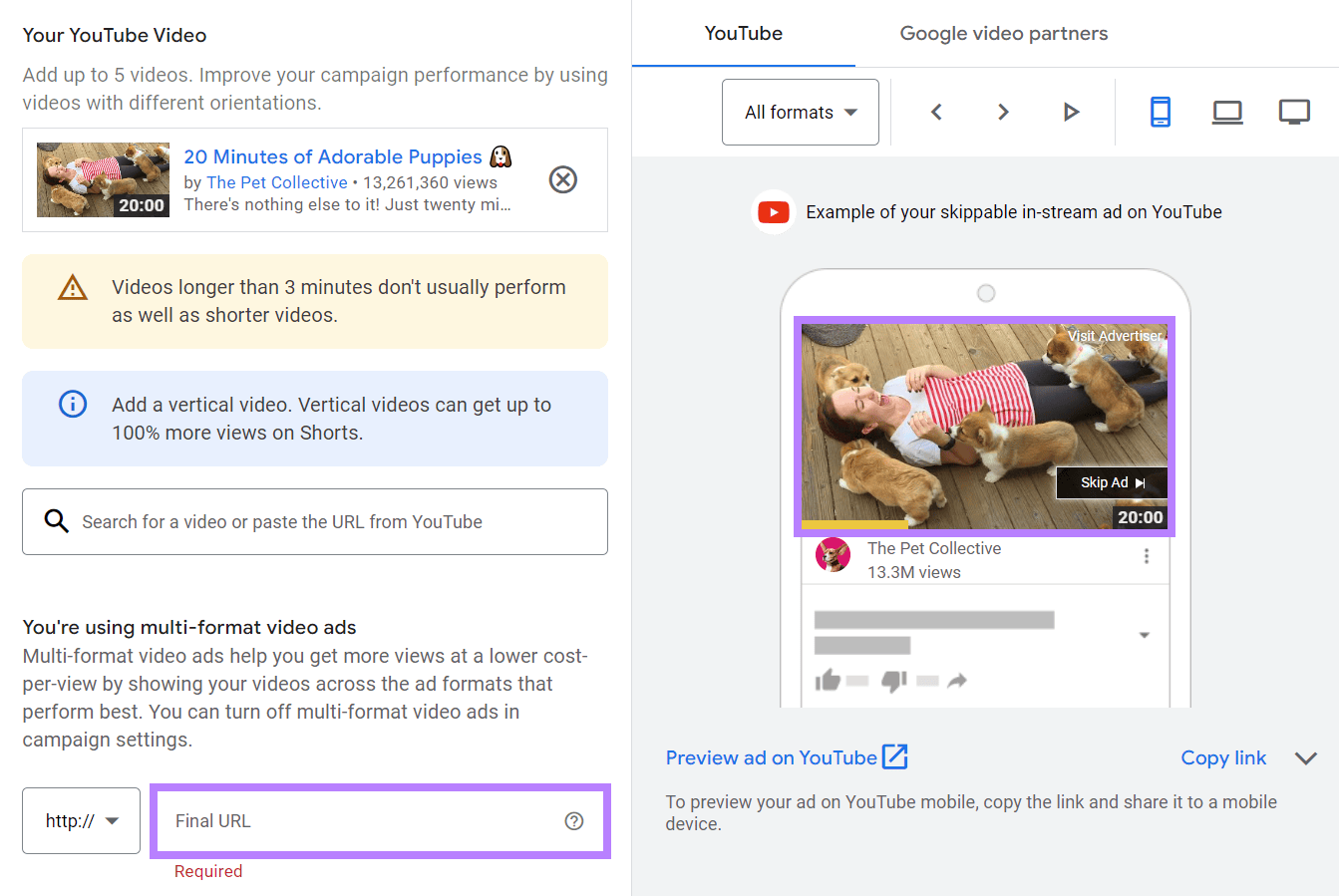
Scroll down to edit other settings like your Display URL (so users understand what to expect when they enter your landing page), CTA (if you tick the option), long headline, and description.
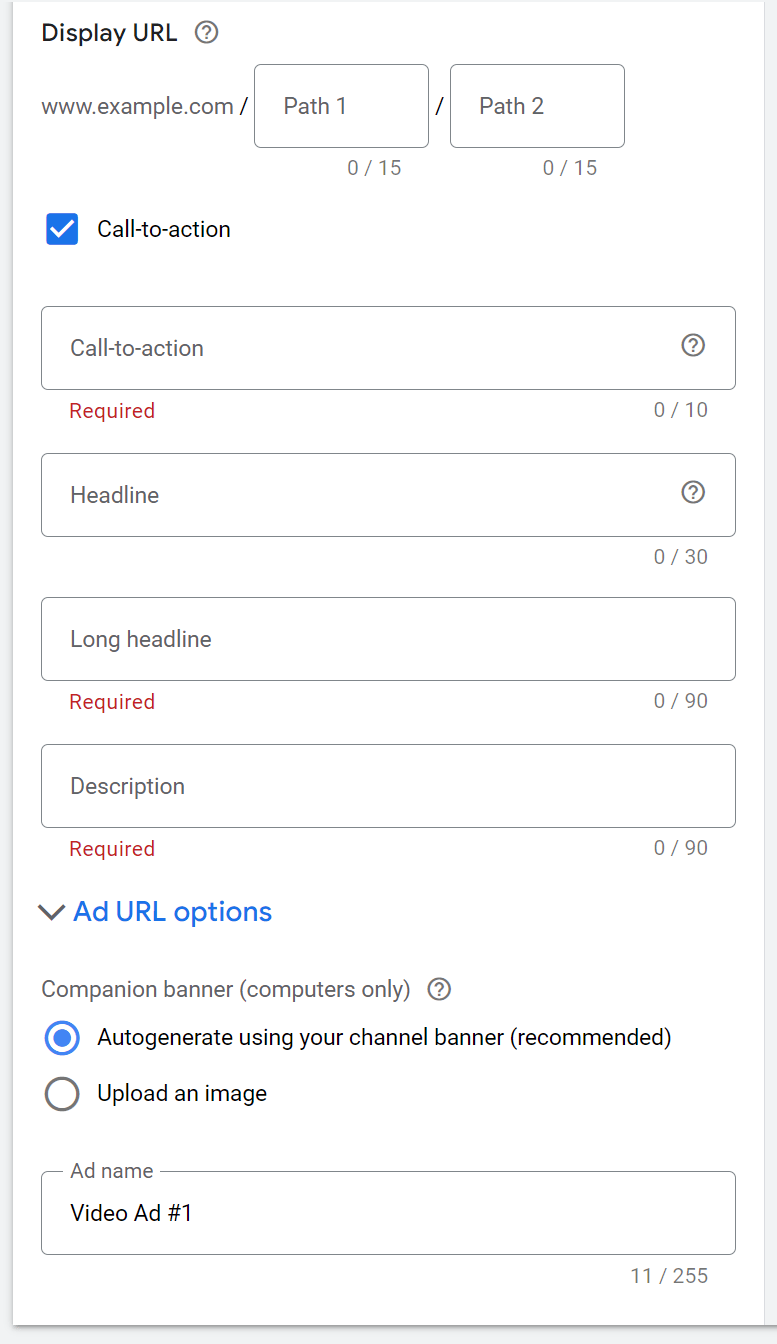
Set your bid.
The target cost-per-view (CPV) bid tells Google Ads how much you want to pay, on average, when a user views your ads.
You might encounter other bidding strategies like:
- Target CPM (cost per thousand impressions): Tells Google Ads how much you want to pay, on average, for every thousand views (impressions) of your ads
- Target CPA (cost per action): Tells Google Ads how much you’re willing to pay, on average, for a conversion. Like a signup, form fill, purchase, or other action.
- Maximize conversions bidding: Automatically sets your bids to get the most conversions for your campaign without overspending your budget
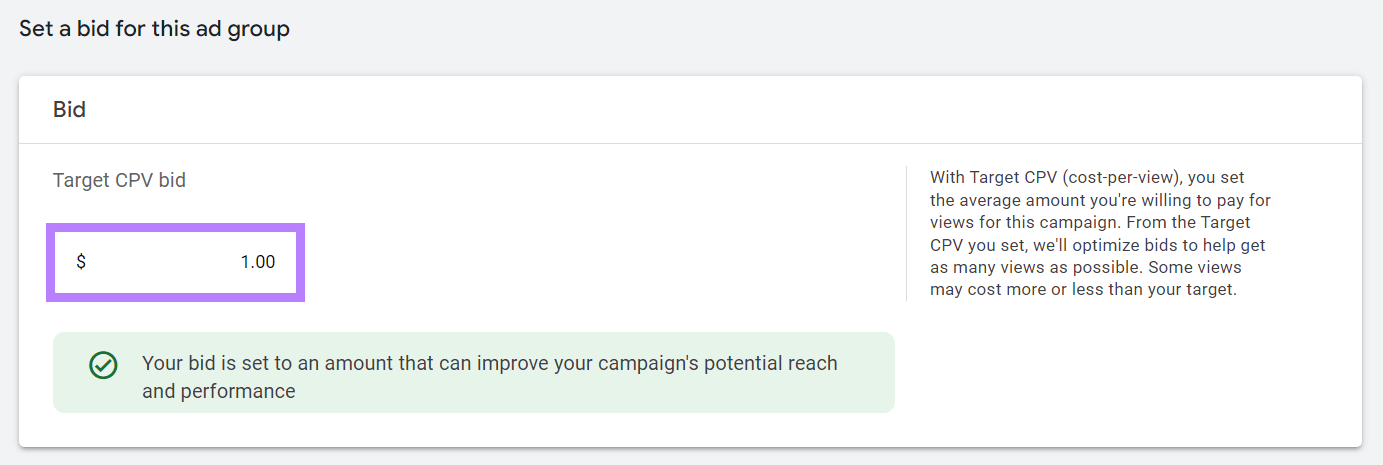
5. Review and Launch Your Ads
Review your Ad Group, Ad Content, and Bid. Then, hit the “Create campaign” button.
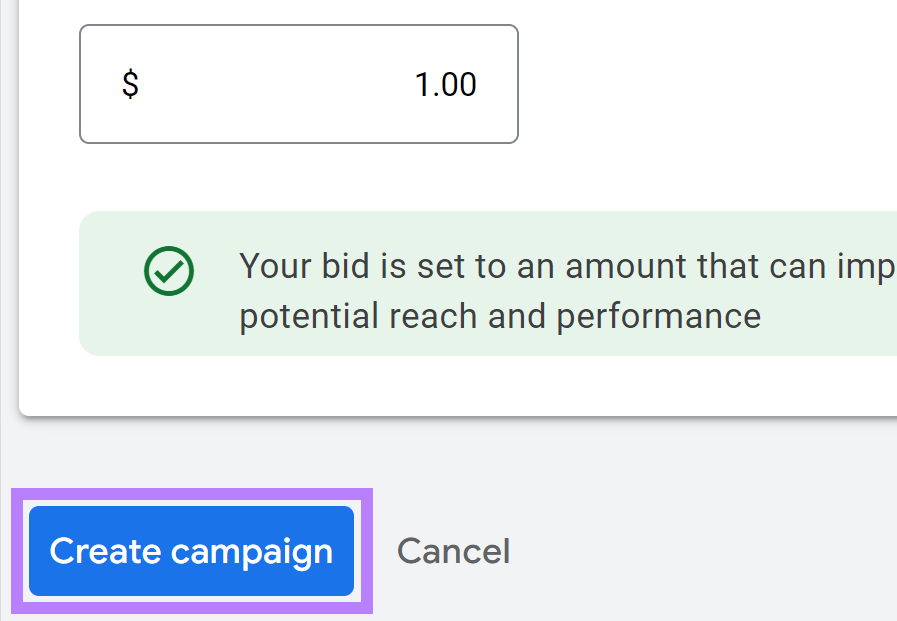
A summary of your campaign settings will appear in a box on screen. Review them to ensure everything is the way you want. Then click “Continue to overview.”

Your ads are now live.
Advanced YouTube Ad Targeting Strategies
Advanced YouTube ad targeting strategies provide experienced marketers with sophisticated tools to fine-tune their campaigns.
These more specific settings let you focus on precise audience segmentation. This can help drive engagement and enhance campaign performance.
Here are three to consider using:
Custom Segments
Custom segments allow you to target YouTube viewers based on their recent Google searches. This can help you reach users who clearly intend to purchase something. Or learn more about a specific topic.
When you use custom segments, your ads are shown to your previously selected audience and the new, intent-based segments. This expands your reach to include users actively seeking related information or products.
Start by identifying your YouTube channel’s core theme. Let’s say your channel is all about healthy eating. This theme becomes your foundation.
Next, identify keywords and phrases that potential viewers might use on YouTube when searching for content related to your theme. YouTube research tools can help.
Keyword Analytics for YouTube from Semrush helps you to find popular keywords that users search for on YouTube. It even helps you identify YouTube search trends.
Open the tool and in the “Keywords Research” column, click “Get started.”
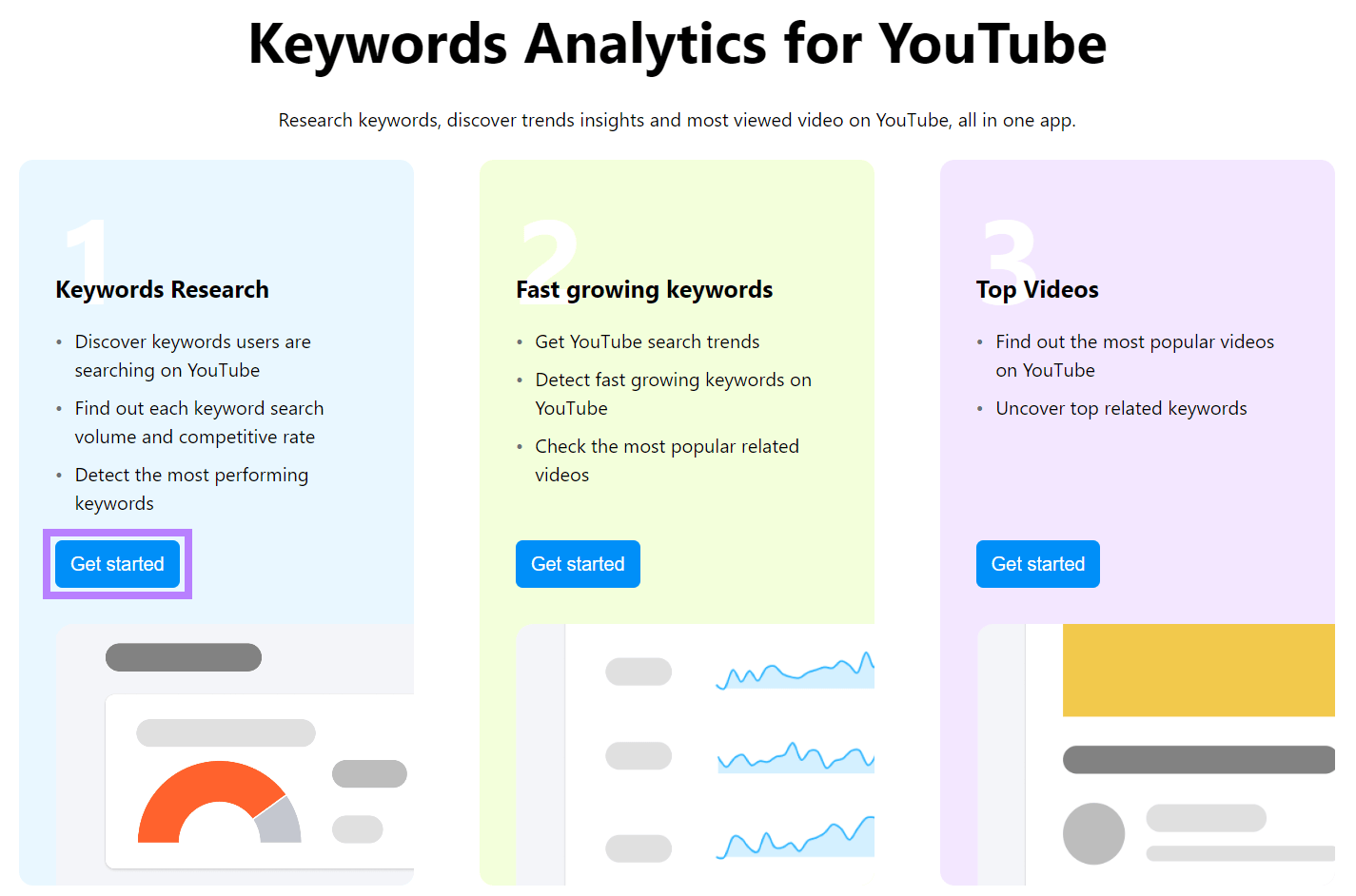
You’ll see a dashboard that provides an overview of the most popular keywords on YouTube for a specific location and time period.
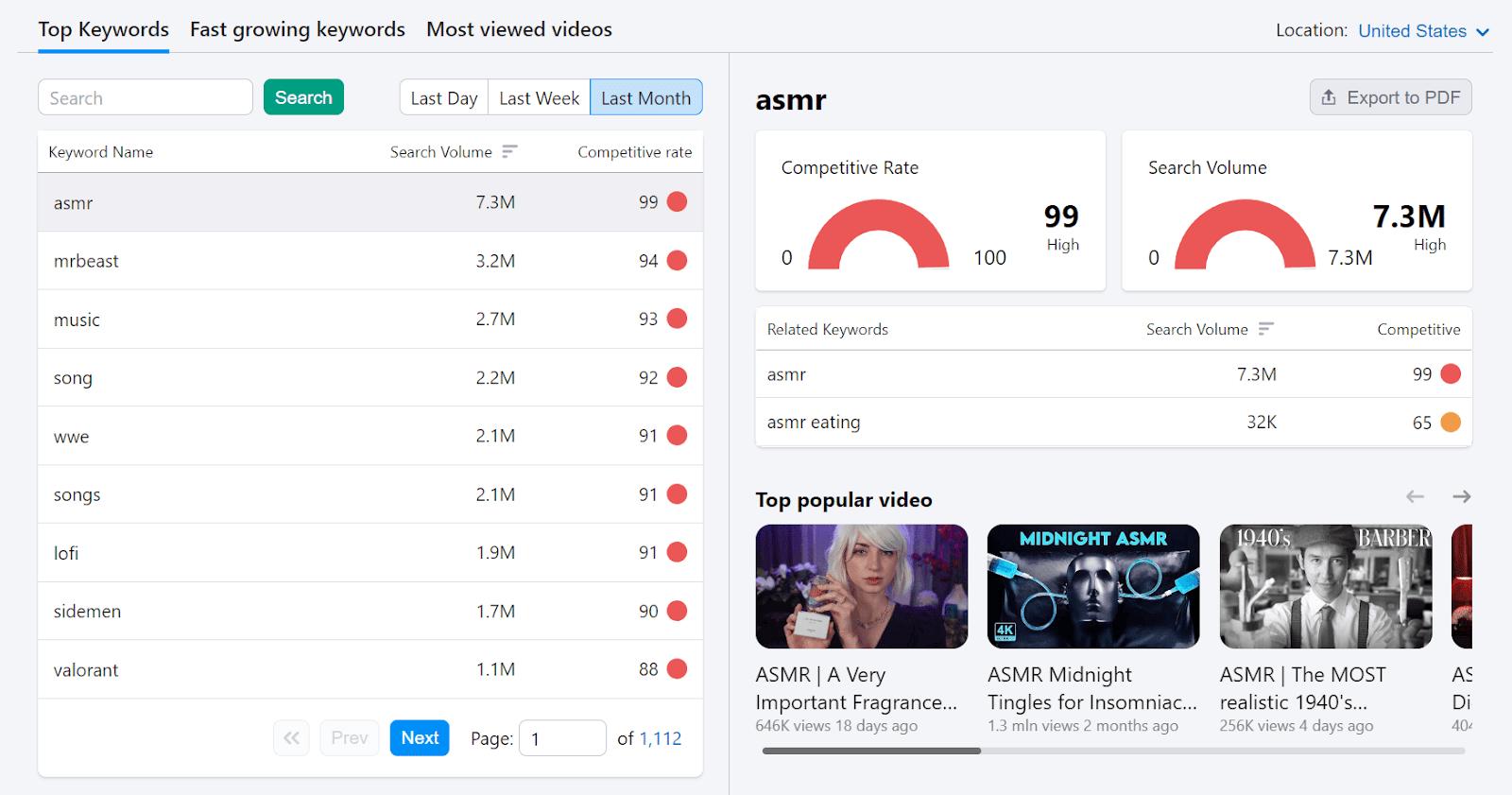
Enter the broad search term that describes your YouTube channel’s central theme in the box. Then hit “Search.”
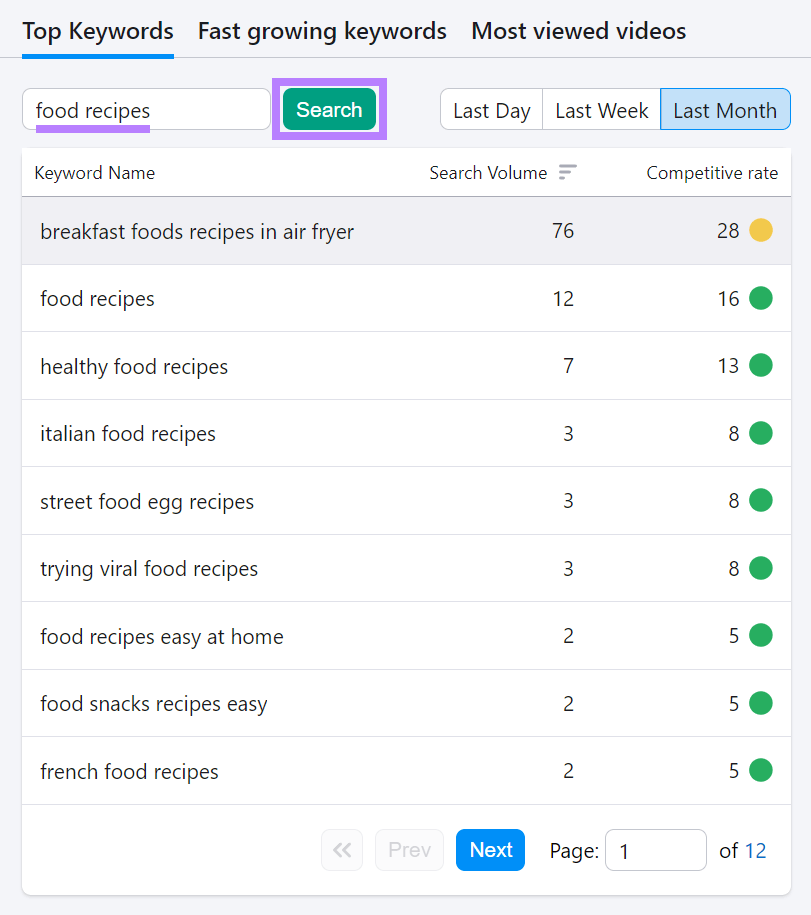
You’ll get data from a specific period of time. Like the last day, week, and month.
Toggle between these periods and the “Top Keywords” and “Fast growing keywords” tabs to find the most relevant keywords for your channel.

Click on a keyword to get more insights. Like competitive rate, search volume, and related keywords.
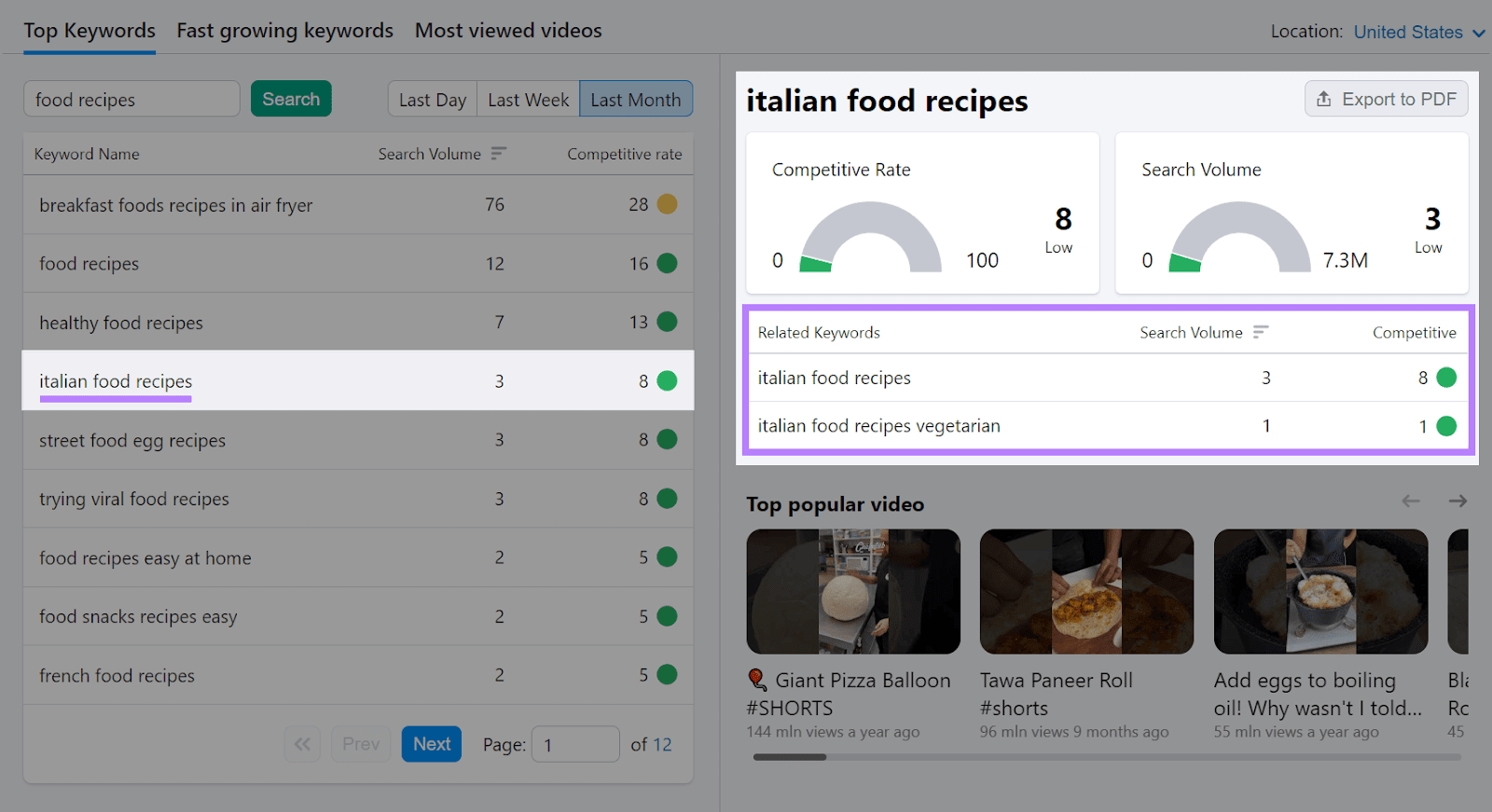
Create a list to keep track of potential keywords. On it, record those most relevant to your ads.
Next, create a custom audience segment in your Google Ads account.
Select “Tools” > “Shared library.” Then choose “Audience manager.”
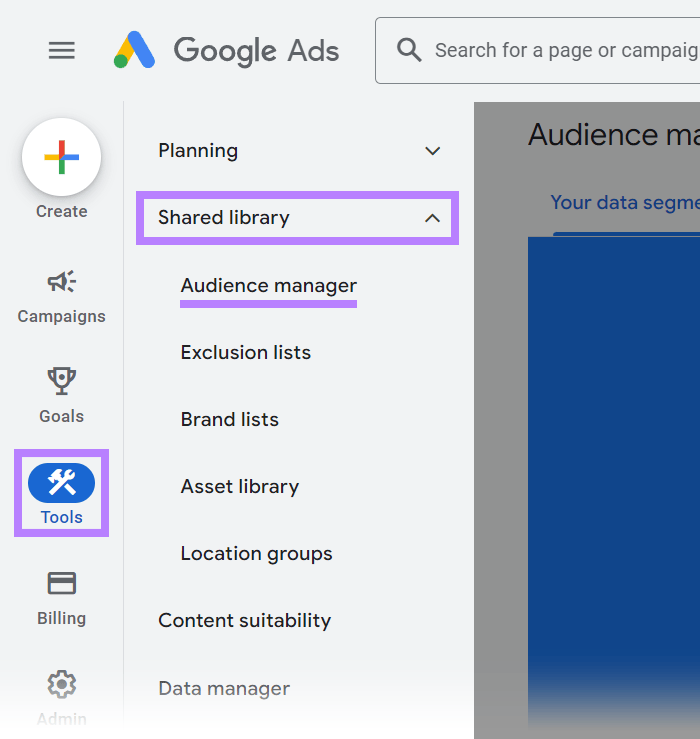
Go to the “Custom segments” tab. Click the “+” sign in the upper left to create your custom segment.
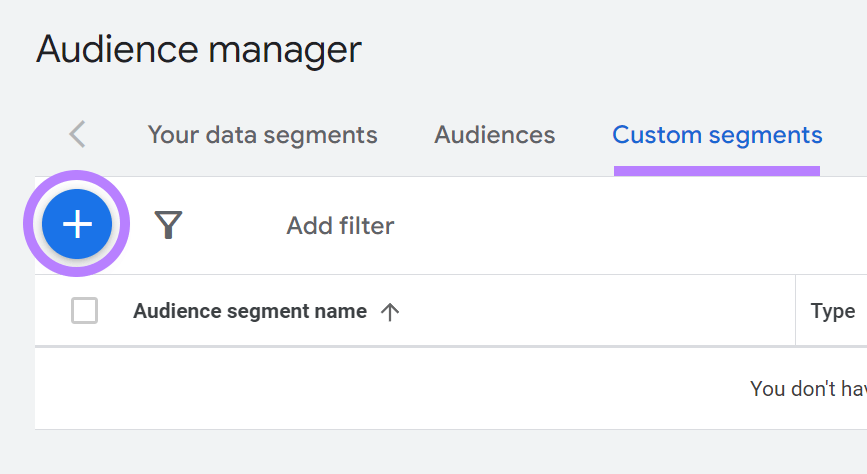
Name your segment.
And choose to target:
- People with any of these interests or purchase intentions. Use this option when your keywords match your audience’s hobbies, or the products and services they’re considering. This will target users based on their demonstrated interests or their active research into specific purchases.
- People who searched for any of these terms on Google. This method focuses on users based on their search queries, capturing those with a direct intent related to your keywords.
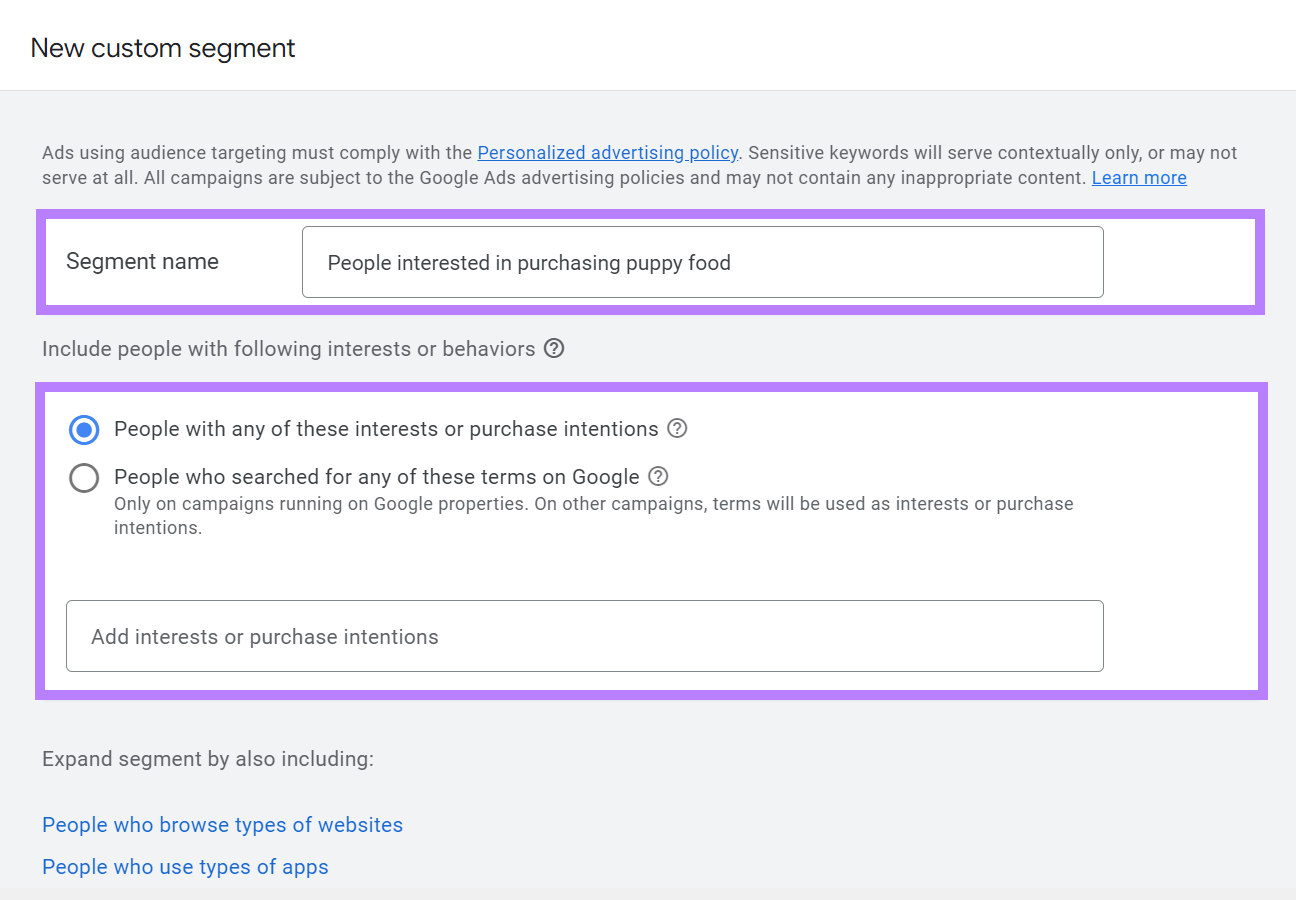
Enter relevant keywords from your keyword list into the text box where it says “Add interests or purchase intentions.”
If you’d like, expand your custom audience segment by targeting people who browse certain websites or apps.
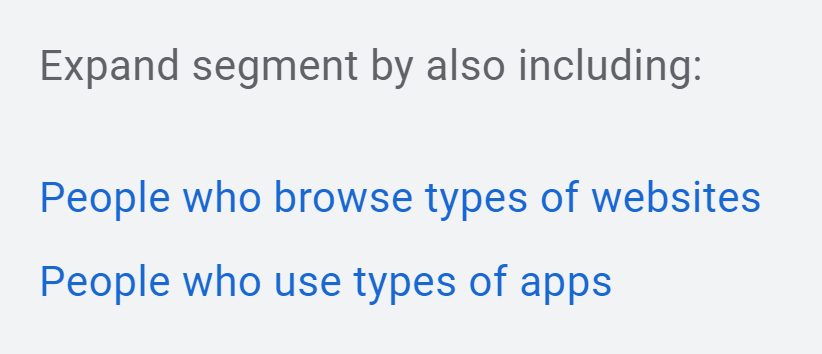
Click the “Segment insights” menu on the right-hand side to view and add your target audience’s location, language, and campaign type.
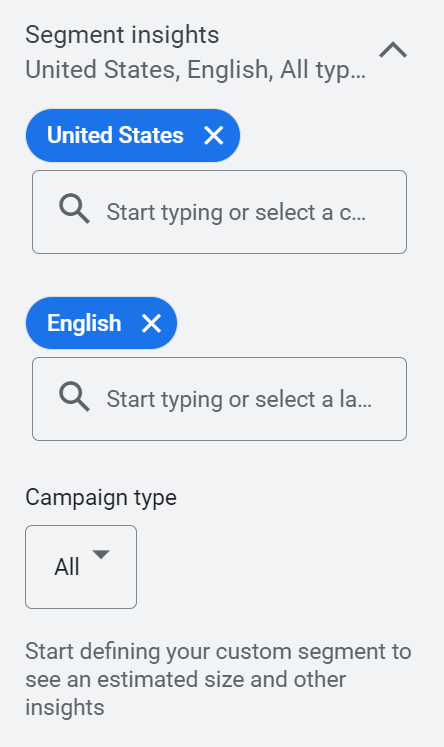
To specify YouTube ad targeting, click “Campaign type” and select “Video.”
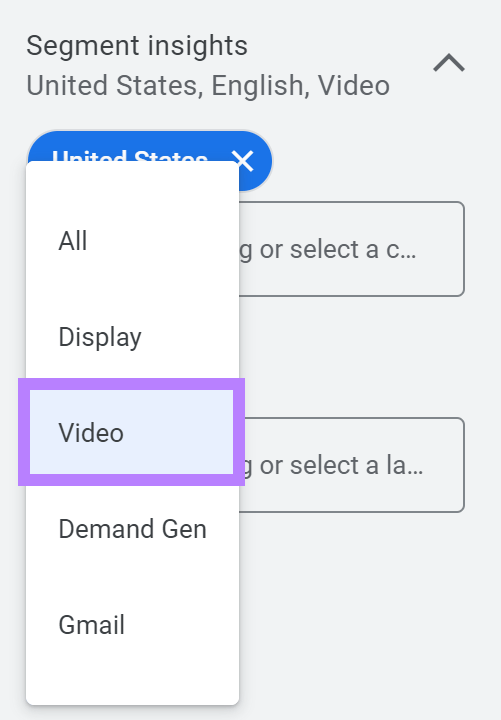
You’ll see estimates of your audience size based on gender, age, and parental status. Click “Save” to finish.
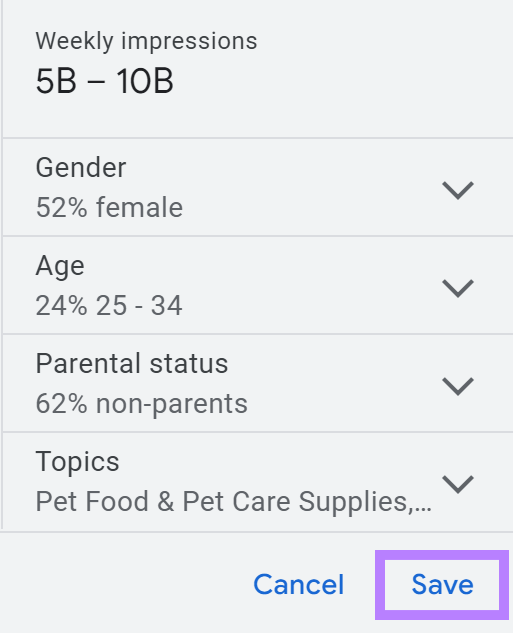
Go to “Campaigns” > “Audiences, keywords, and content.” Then select “Audiences.”
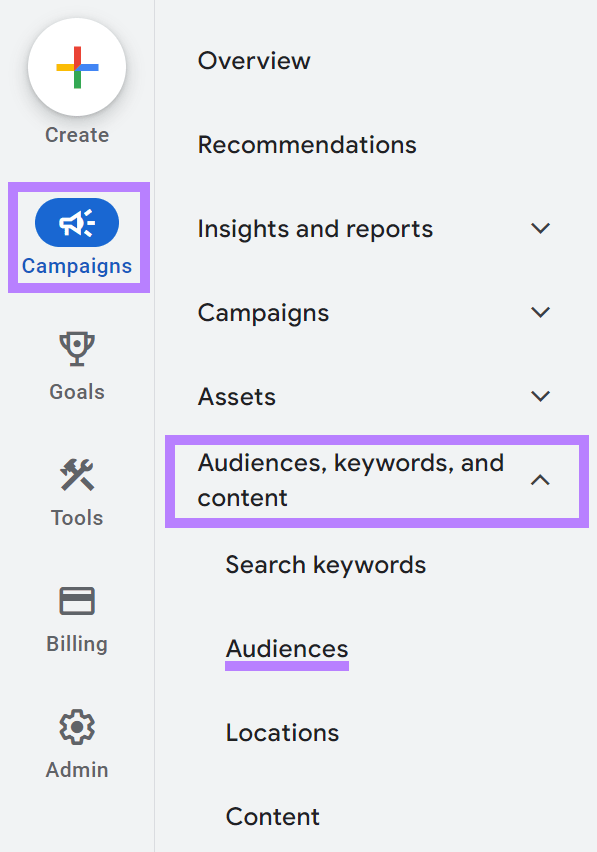
Click “Add audience segments.”

Select “Ad group.”
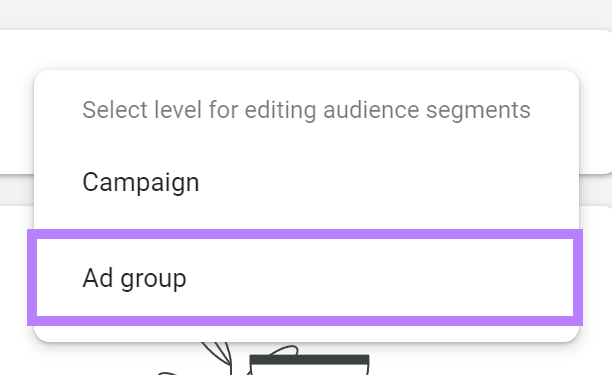
Select your campaign. And the ad group that you want to add the custom segment to.
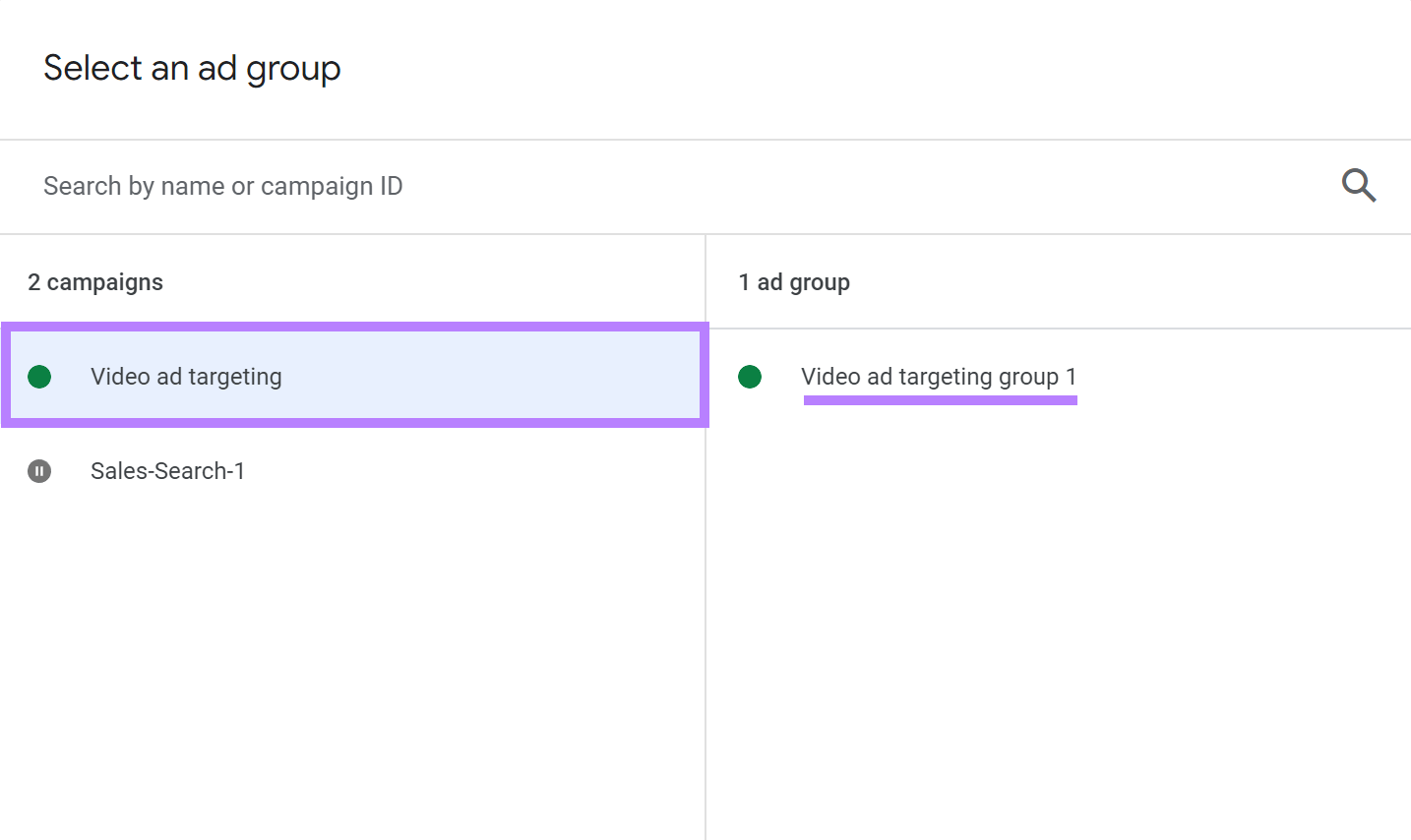
Tick the checkboxes next to the segments to select them. Then, click “Save.”
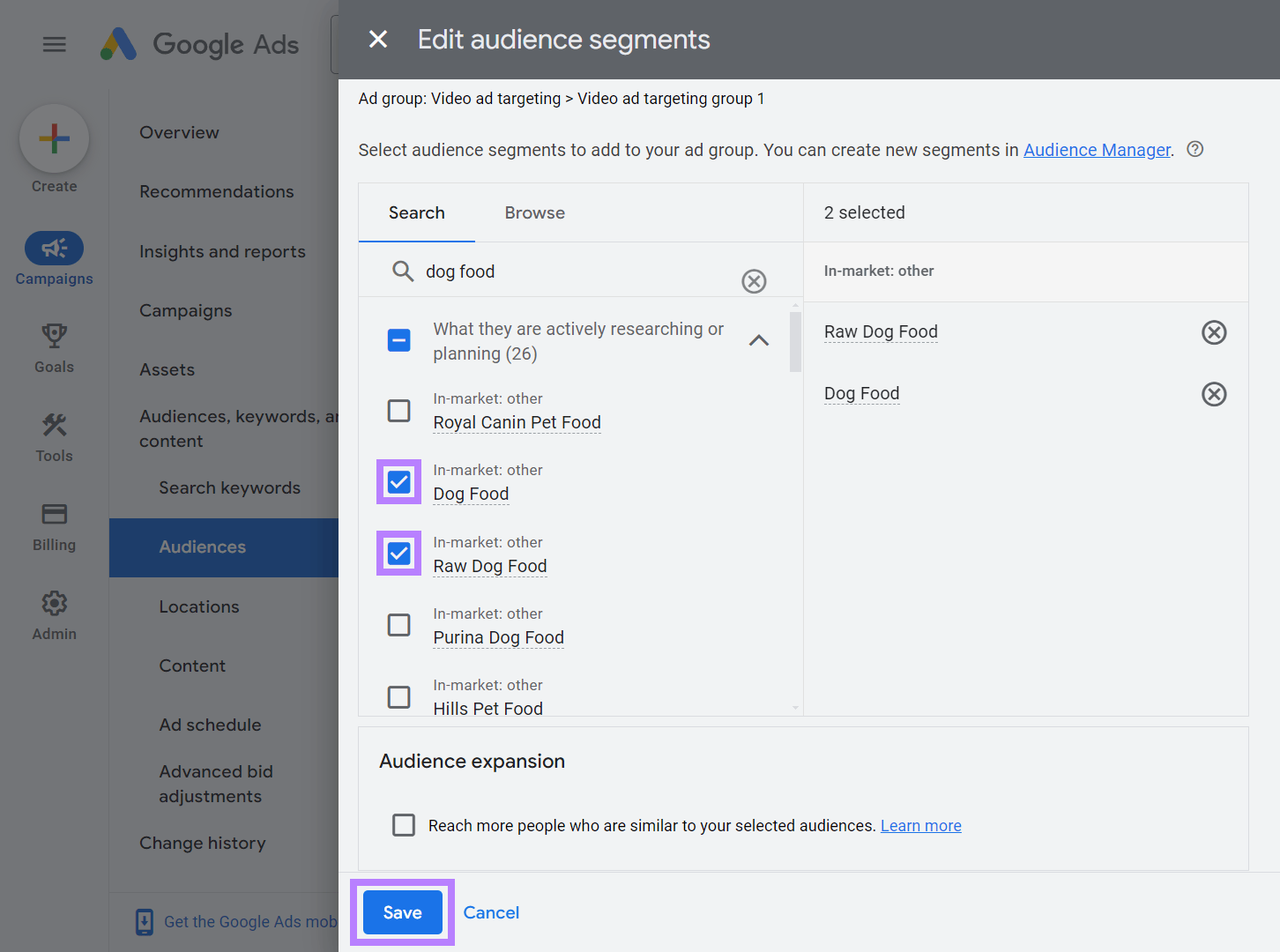
You’ve now added the custom segments to your YouTube ad group. Your ads should now reach viewers within that segment.
Remarketing allows you to reconnect with individuals who have interacted with your videos, channel, or website before. Targeting these past viewers or visitors with your ads can increase the likelihood of re-engaging them, since they’ve already shown interest in your brand.
In your Google Ads account, click “Tools” > “Shared library.” Then click “Audience manager.”
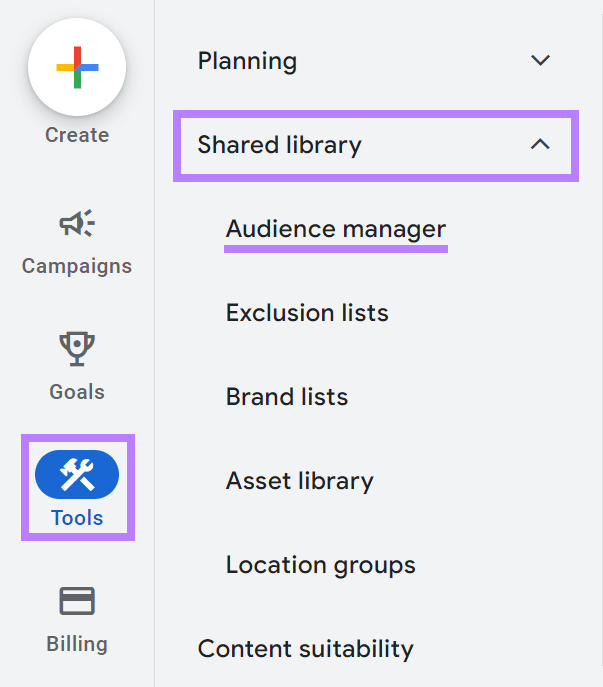
Click on the “+” sign under the “Your data segments” tab.
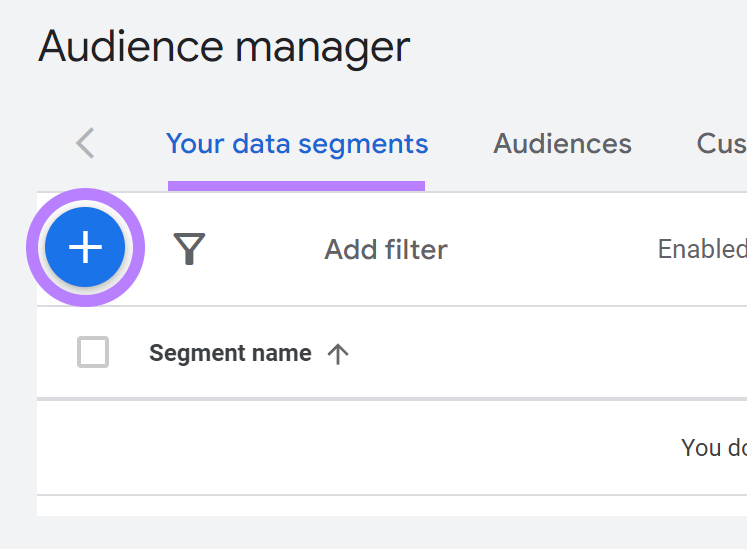
Select “YouTube users.”
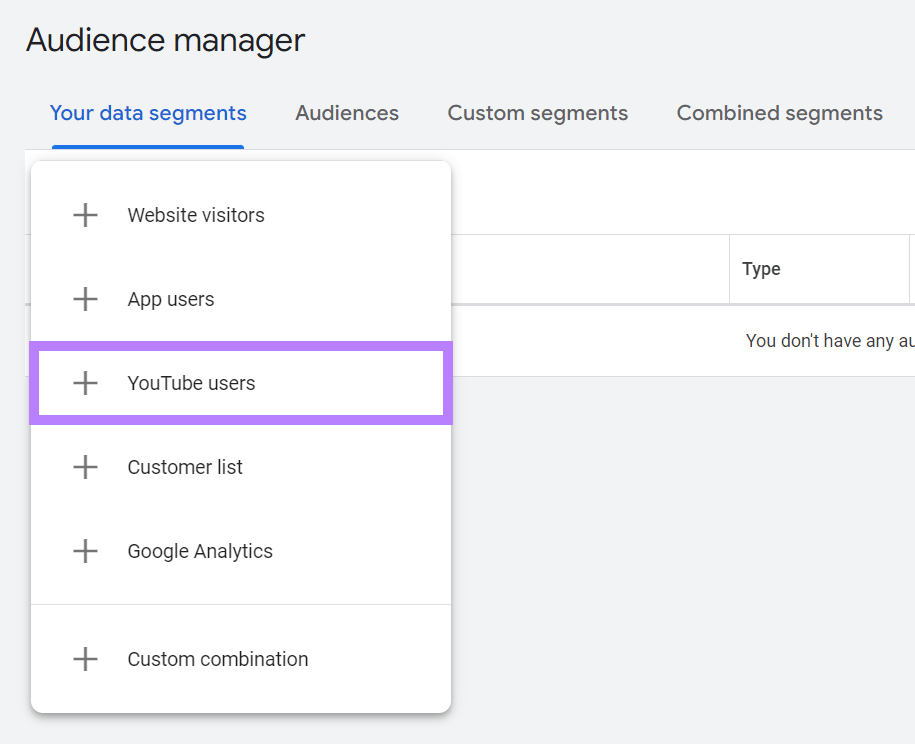
In the respective input box, add your segment name. Then, choose your YouTube channel. Describe the previous actions of the people you intend to retarget.
For example, you may want to retarget people who have viewed any video in your channel in the past 30 days.
Click “Continue.”
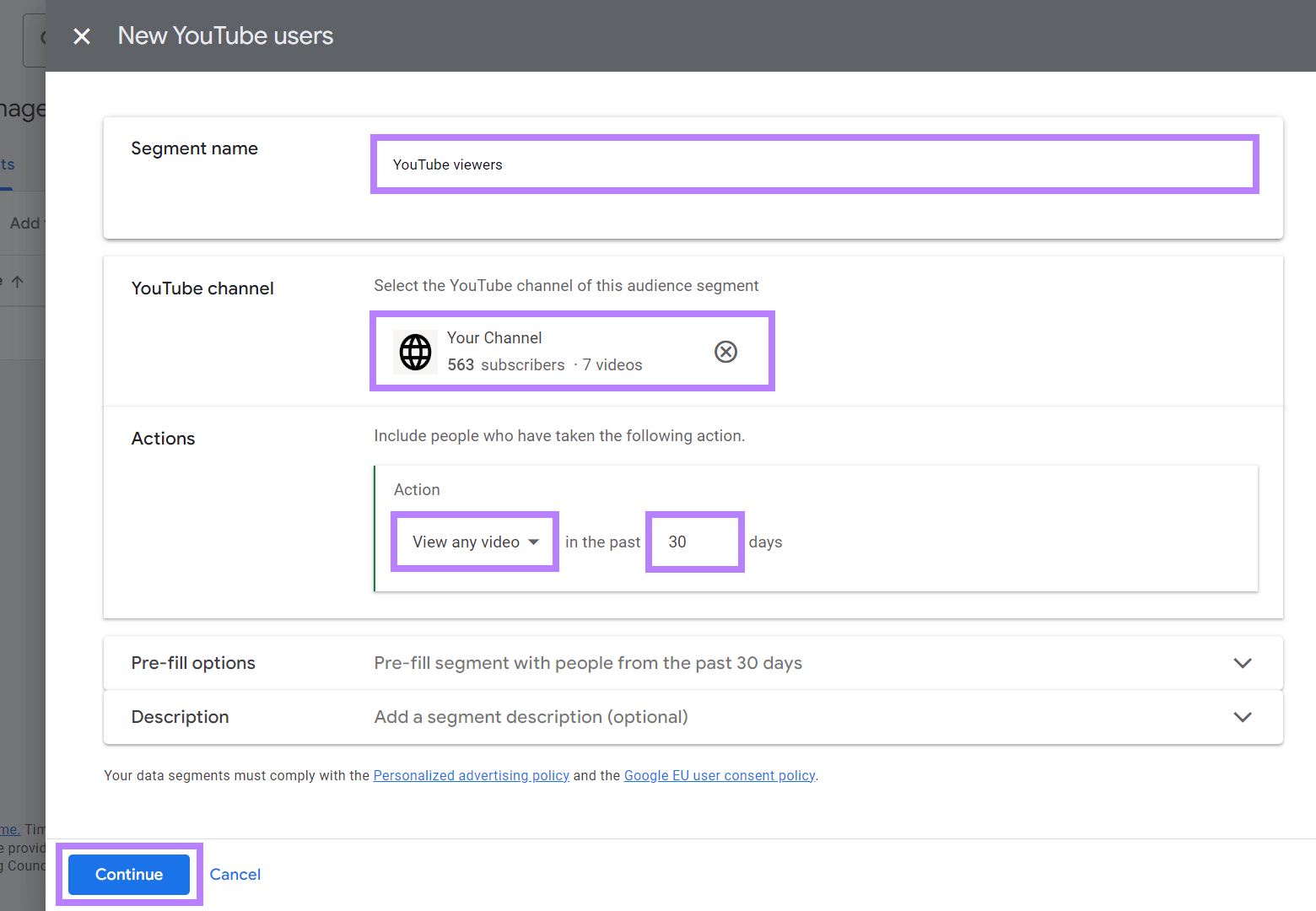
You’ll see a notification that you’ve created a new YouTube users segment. Click “Done.”
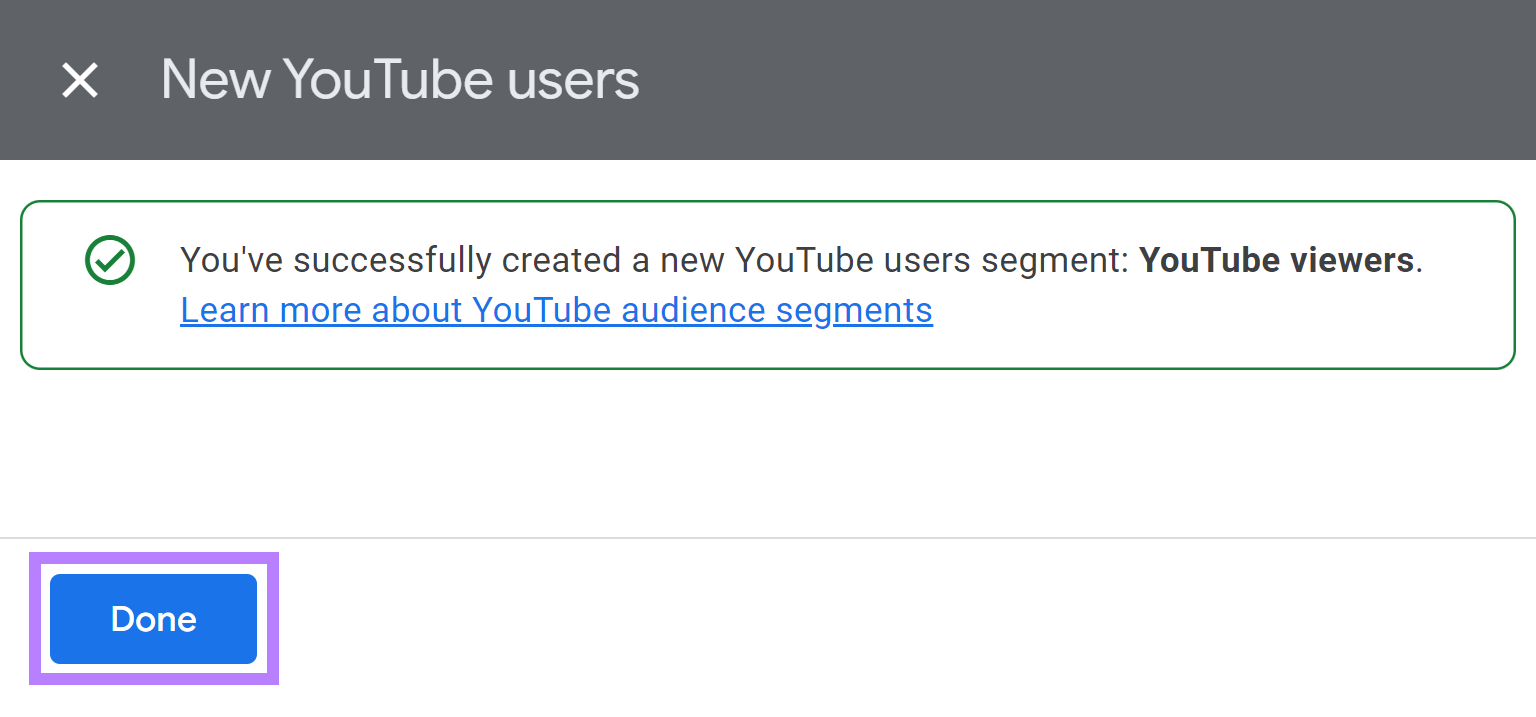
Then, add the list to your YouTube ad group.
On the “Your data segments” table, check the box next to your new remarketing list. Click the “Add to…” drop-down menu.
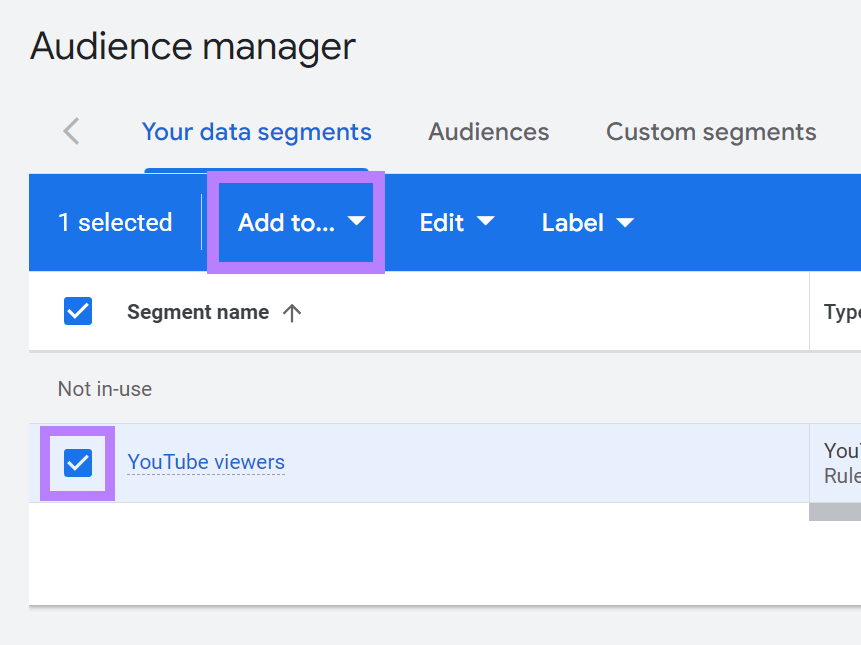
Select “Ad groups.”
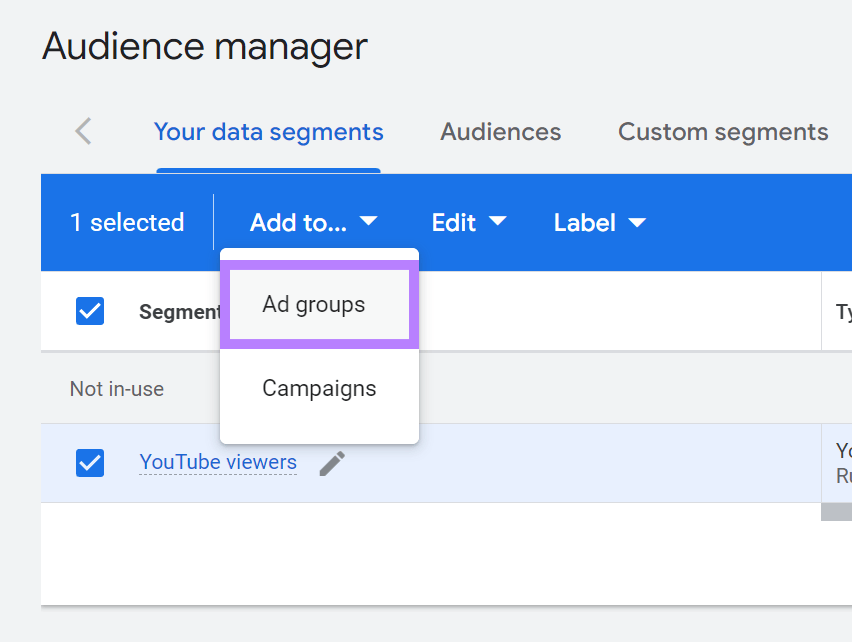
Select your campaign and ad group. Then, click “Add audience segments.”
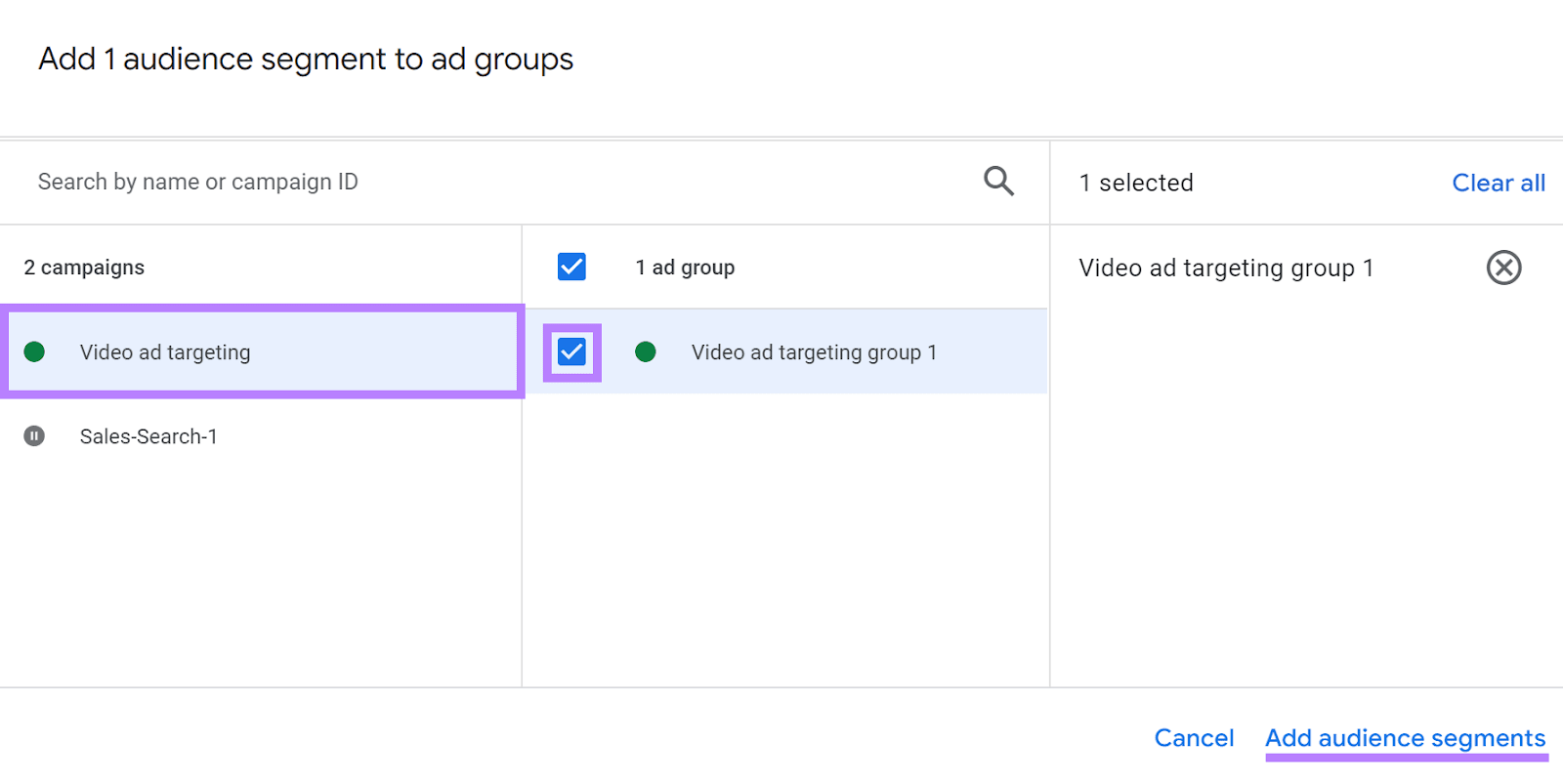
At this point, Google Ads will return you to the “Audience manager” screen.

Video Placement Targeting
Video placement targeting lets you specify exactly where your ads appear on YouTube. You can select specific videos, channels, or categories that align closely with your brand and audience interests.
This type of targeting asks Google Ads to show your ads in contexts highly relevant to your target audience.
Start by researching YouTube channels and videos that are popular with your target audience. Or relate directly to your product or service. Consider channels or videos with content that complements or is directly associated with your brand.
Have your list ready?
From your Google Ads account, go to “Campaigns” > “Campaigns.” Then choose “Ad groups.”
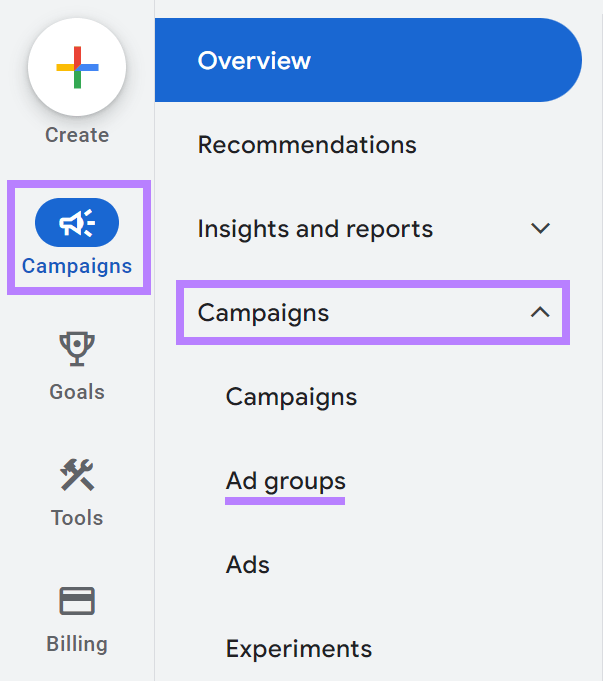
Click on the ad group where you want to add specific placements.
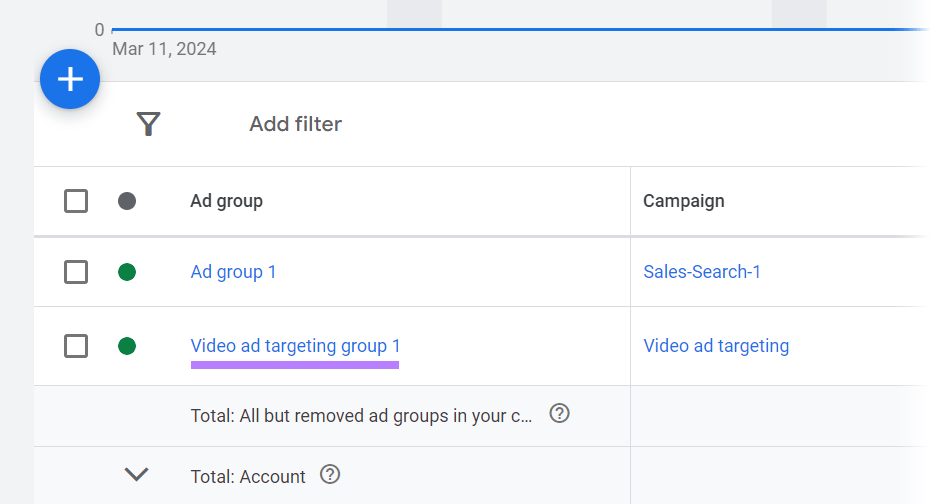
On the left-hand sidebar under “Audiences, keywords, and content,” click “Content.”
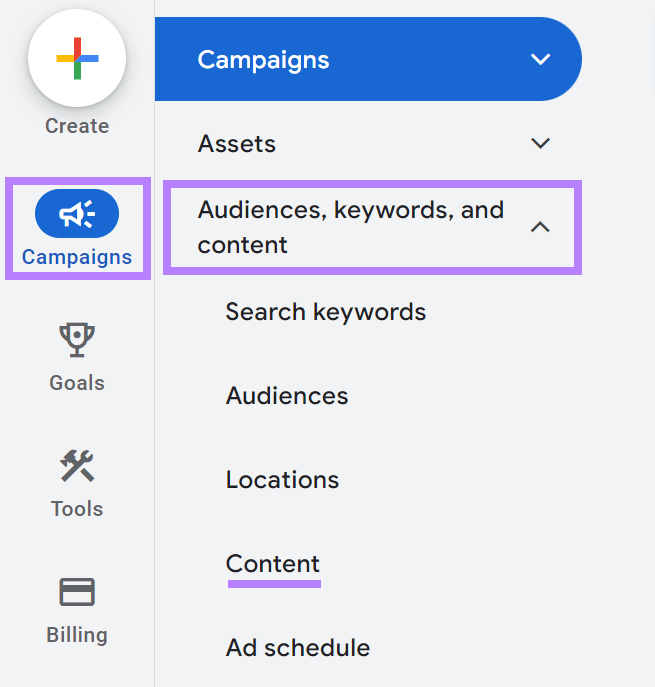
Scroll down and click on “+ Add content.”
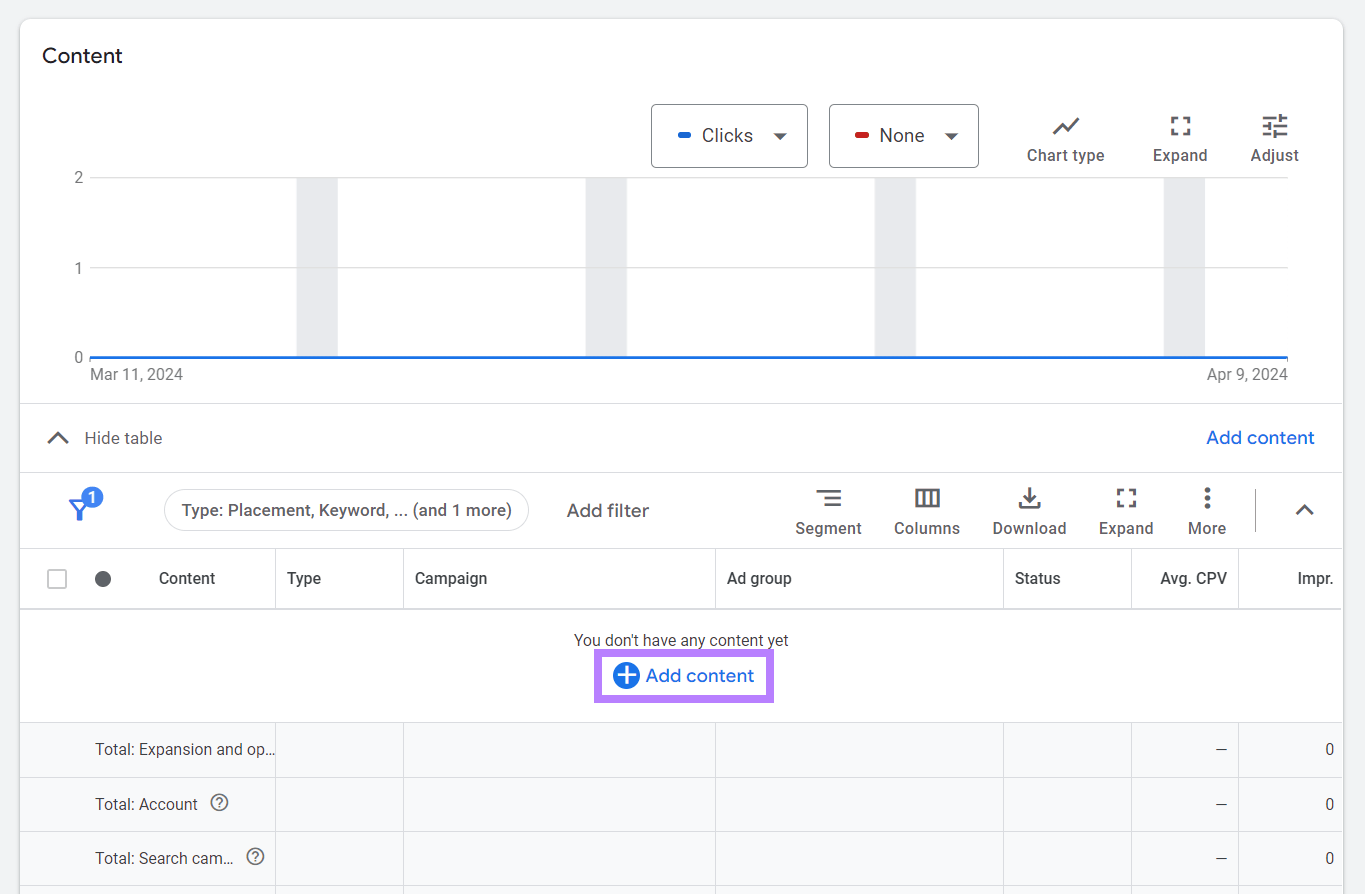
Select your YouTube ad campaign and ad group.
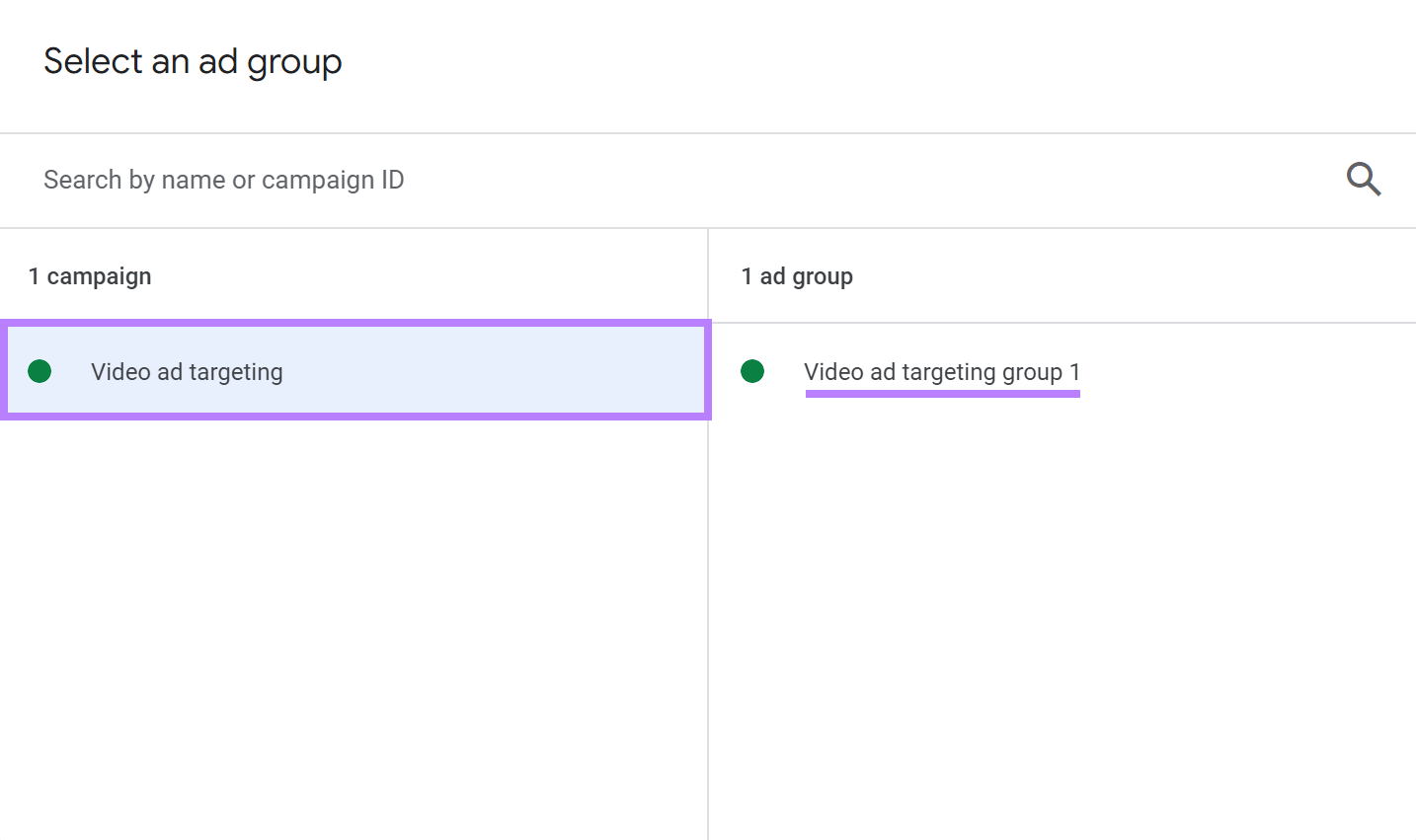
Expand the Placements tab.
You’re going to select the specific YouTube channel video, or other placement you want your ad to appear on.
To find your desired placement, either:
- Search for the placements you want using the “Browse” tab
- Enter the URLs for those placements you want using the “Enter” tab
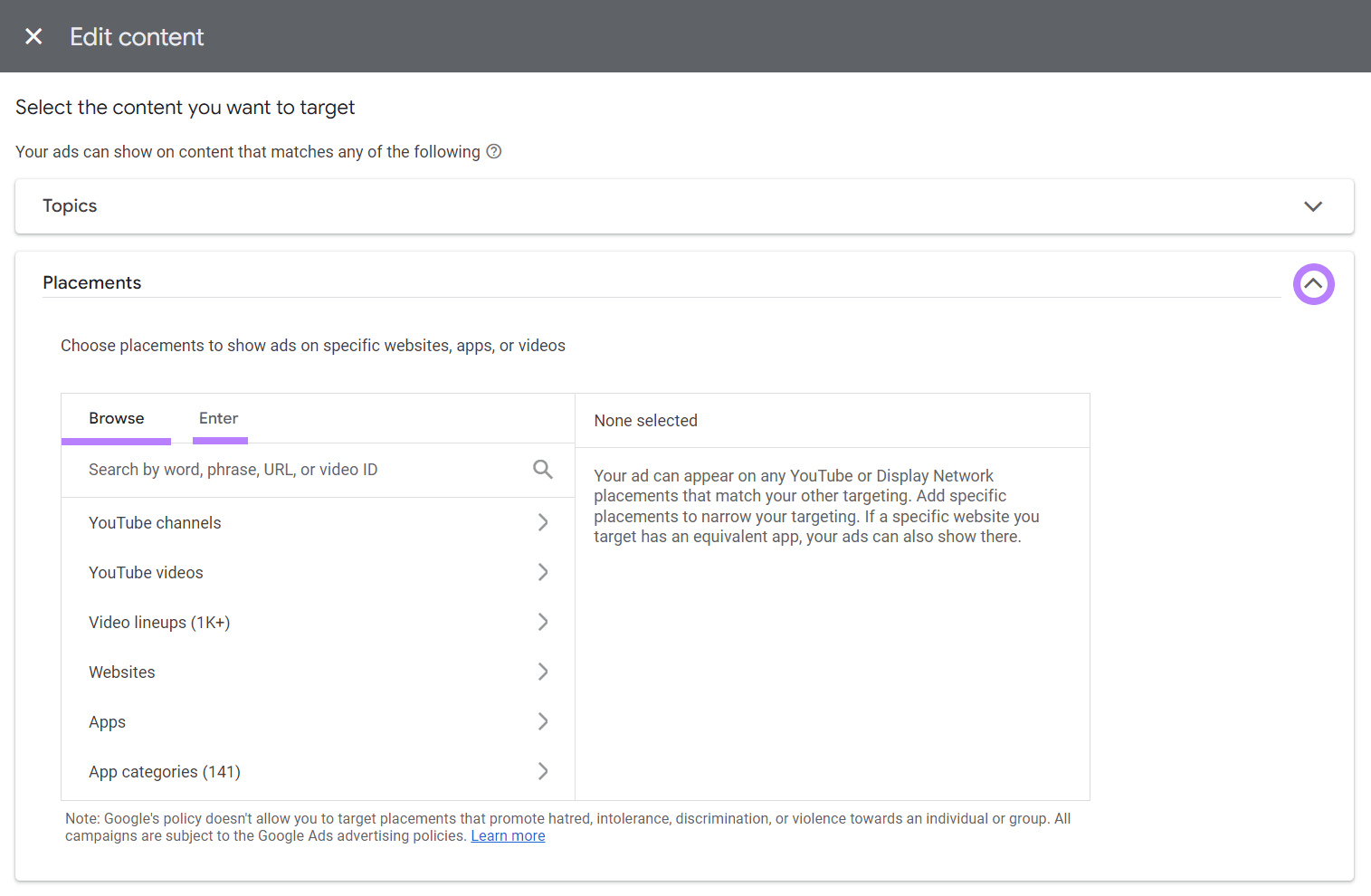
Click the “Save” button to finish.
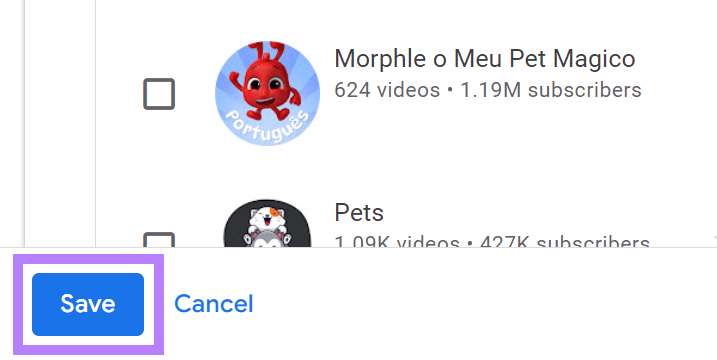
How to Measure and Optimize Your YouTube Ads
To make sure your YouTube advertising efforts are working, measure ad performance and optimize based on the data you collect.
Use these tools to monitor the performance of your YouTube ads.
Google Ads
Google Ads gives you access to essential numbers. Like how many people saw your ad, clicked on it, and took an action such as making a purchase.
Click “Campaigns” under “Campaigns” > “Campaigns.”
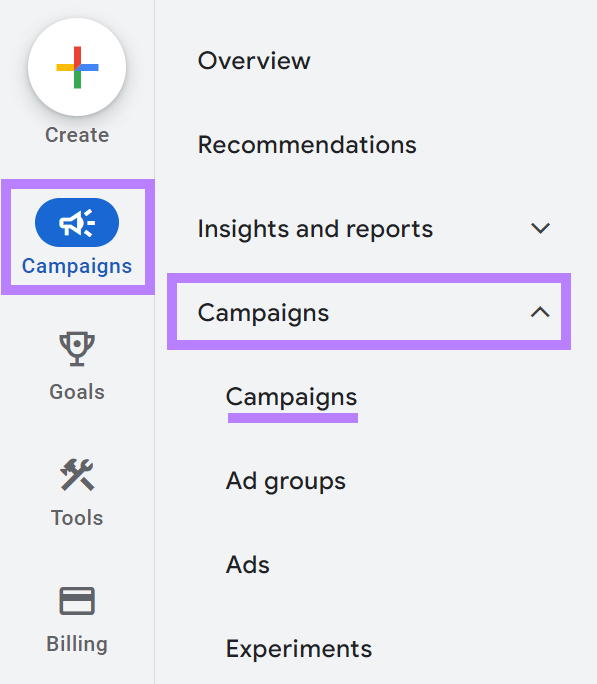
On the “Campaigns” table, click on the specific YouTube ad campaign you want to analyze.
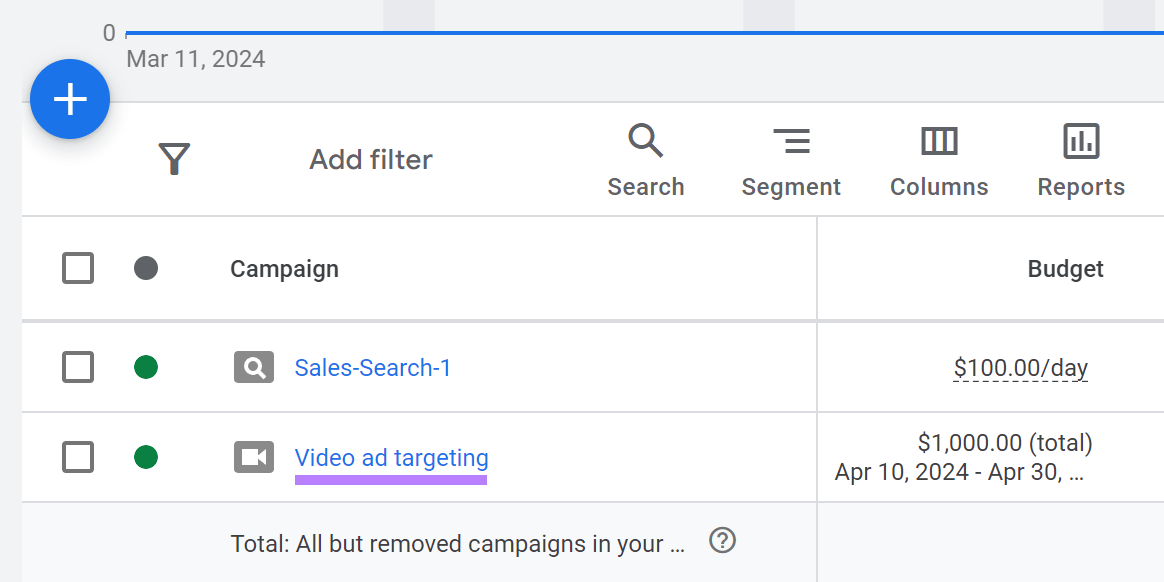
This will open the campaign’s performance dashboard.
On the campaign dashboard, you’ll see several key performance metrics, such as:
- Impressions: The number of times Google Ads showed your ads
- View rate: The percentage of viewers who watched your ad
- Clicks: How many times viewers clicked on your ad
- Cost-per-view (CPV): The average cost for each view
These metrics give you an overview of how well your ad is performing regarding visibility, engagement, and cost efficiency. Use the data to adjust your target audience, change your bid strategy, or tweak your ad creative.
Here are some practical tips to follow:
Review the demographics and interests of the viewers engaging with your ads. If you notice trends, such as a particular age group showing more interest, refine your audience settings in Google Ads to target this group more intentionally.
Look at your ads’ cost-per-click (CPC) or CPV. If you’re spending too much without seeing results, consider lowering your bid. However, if you’re getting results and have room in your budget to increase visibility, try raising your bid slightly.
Analyze which ads are performing well and which aren’t. Look for patterns in the messaging, visuals, or CTA that might explain the difference. Use these insights to modify underperforming ads.
Here’s an example of metric-based ad optimization:
Let’s say you’re running a YouTube ad campaign for customized bracelets. After reviewing your ad data, you notice that:
- Your ads are mostly viewed by 25-34 year olds, but initially, you targeted a broader age range
- The CPC is higher than you’d like, indicating your bid might be too aggressive
- Ads with a clear, concise CTA (“Shop Now!”) are outperforming those with a vague CTA (“Learn More”)
Based on this data, you might decide to:
- Narrow your target audience to focus exclusively on the 25-34 age group
- Lower your bid slightly to reduce the CPC while monitoring the impact on ad visibility
- Update all ads to include a direct and clear CTA, aiming to increase conversions
YouTube Analytics
YouTube Analytics can also help you understand how viewers interact with your ads on YouTube. It provides detailed insights into your ad performance, enabling you to make informed decisions to optimize your campaigns.
On the left side of your YouTube Studio’s homepage, click “Analytics.”
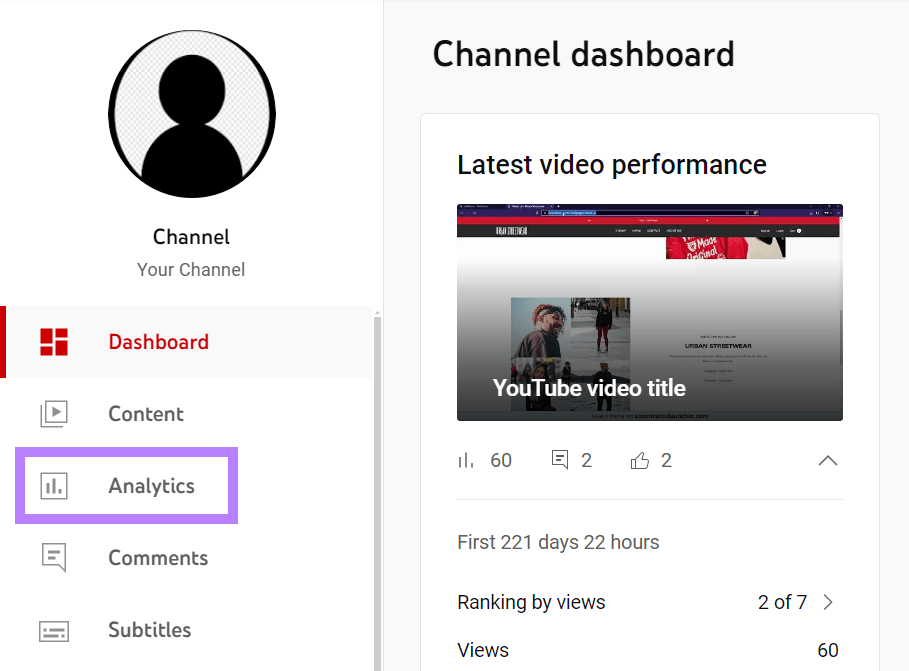
The default “Overview” tab gives a snapshot of your ad’s performance. Including views, watch time, and engagement metrics such as likes, shares, and comments.

The other tabs:
- “Content” shows you what your audience likes about your channel. It tells you which videos they’re watching and how they’re engaging with them, like commenting or liking.
- “Audience” shows you who’s watching your videos. It summarizes your viewers, including information on their interests and demographics.
- “Research” provides insights into your audience’s and other viewers’ search queries on YouTube. This helps you align your content with viewer trends and demands.
Here’s what you can do with the information from these tabs:
- “Content”: Look for patterns in the videos that receive more engagement (likes, comments) and views. Create more content similar to these successful videos. If you notice high engagement rates on specific topics or formats, create series or follow-up videos related to these topics.
- “Audience”: Tailor your future content and posting schedule based on your audience’s demographics. If your viewers are primarily in a specific age group or geographic location, create content that resonates with their interests or cultural references. Use the interest data to explore new content themes or video ideas that align with what your audience enjoys outside of your channel.
- “Research”: Discover what topics or questions your potential audience is actively searching for on YouTube. If you find recurring themes or specific queries related to your niche, consider producing content that directly answers these questions or covers these topics.
Take it a step further by:
- Using the insights from the “Content” and “Audience” tabs to plan your content calendar. Include videos that match your audience’s preferences and engagement patterns.
- Using the “Research” tab data to refine your SEO strategy for YouTube. Focus on related topics and questions your audience and other viewers actively search for.
- Encouraging interaction in your videos by asking viewers to comment on topics that drive engagement. Or by creating polls based on popular content themes.
- Collaborating with creators or channels that share a similar audience demographic or interest profile. Tap into each other’s audience and grow.
How to Fix Common Challenges in YouTube Ad Targeting
Navigating YouTube ad targeting can present several challenges. But you can overcome them with the right strategies.
Reaching the Wrong Audience?
Use your understanding of your viewers’ behaviors, interests, and search habits to identify the right audience. Two things help:
- Outline your ideal customer’s characteristics. Consider factors like age, gender, interests, and lifestyle. For example, if you’re selling fitness equipment, your ideal customer might be fitness enthusiasts, 20-40 years old. This demographic should be searching for, or watching health and wellness content.
- Use tools like Google Ads to understand who’s visiting your channel and watching your videos and ads. Look for trends in the “Demographics” tab and the “Interests” section to understand who is currently interested in your products or services.
Revisit these exercises often. Use the insights to update your targeting. You can also create and use custom segments to target users based on their search behavior.
Further reading: How to Find Your Target Audience
Low Engagement Rates?
Sometimes your ads fail to engage viewers despite reaching the right audience. Solve low engagement rates by optimizing your ad content and format.
Implement these YouTube ads targeting best practices:
- Use a small portion of your available ad budget to test different ad formats within a campaign. Identify the most engaging one using YouTube Analytics. Put the rest of your money behind it.
- Use compelling visuals and stories that connect with your audience’s interests or challenges
- In both your visual content and your narration, include a clear, prominent CTA like “Sign Up,” “Learn More,” or “Buy”
Further reading: Growth ******* Examples to Boost Engagement and Revenue
Ad Fatigue?
Over time, even the best ads can become less effective if the audience becomes tired of seeing them repeatedly. This is ad fatigue.
Regularly update your ad creatives to keep your content fresh by:
- Introducing new visuals, messages, or offers
- Using audience segmentation to deliver tailored ads to different groups
Make the Most of YouTube Ad Trends
Keep track of trends to capitalize on opportunities to compete.
Two trends to watch:
- Personalized ads are getting even more tailored, adapting to each viewer’s preferences and behaviors
- Interactive and shoppable ads on YouTube are set to improve engagement by offering a seamless journey from viewing to purchasing
As competition intensifies, optimizing video content for search will be crucial to maintain visibility and stand out. Stay up to **** by:
- Regularly reading industry blogs (like the Semrush blog), attending webinars, and participating in digital marketing forums to hear about the latest YouTube ad innovations
- Experimenting with new YouTube advertising features and formats to discover what works best for your brand before they become mainstream
- Using analytics tools to monitor your ads’ performance
Keep your strategies effective. Use Semrush tools to adapt to the shifts in YouTube advertising.
Use Keyword Analytics for YouTube to discover trending keywords for new video ideas. And to improve your video titles and descriptions. Use Rank Tracker for YouTube to monitor your channel’s search rankings and analyze competitors to gain insights that inform your content strategy.
Sign up for a free trial to access a whole suite of tools from Semrush that can help your YouTube ads capture your target audience’s attention.
Source link : Semrush.com
